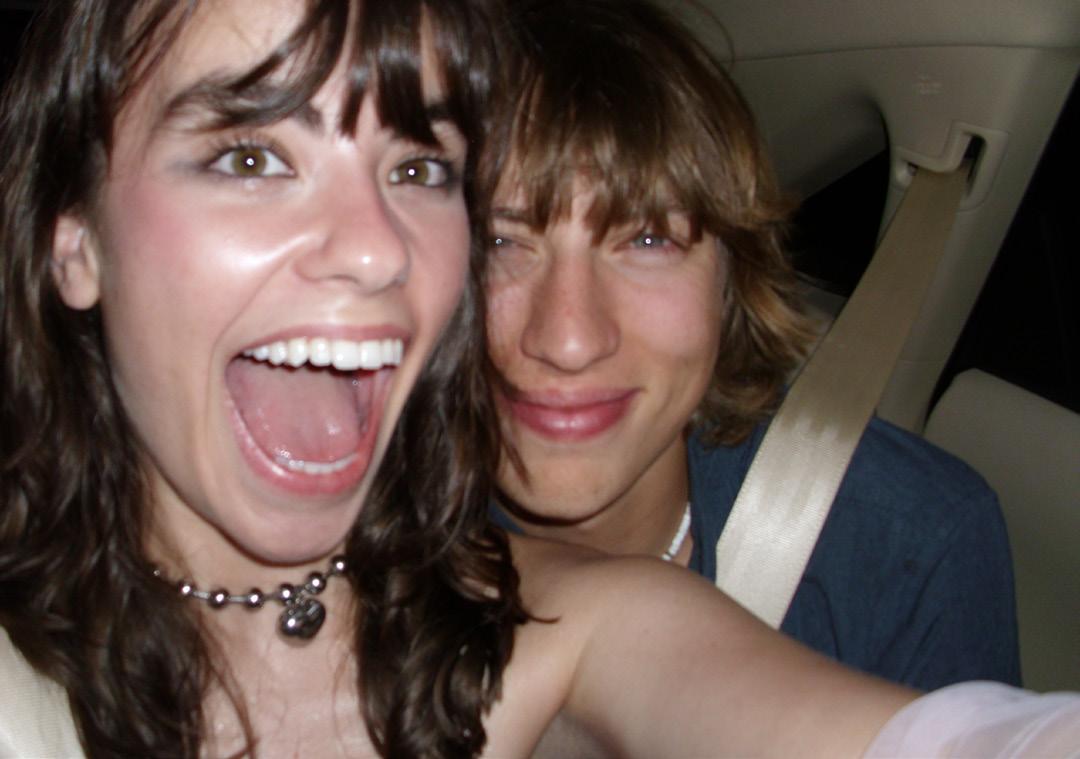

Students and faculty get involved on campus due to recent events





Students and faculty get involved on campus due to recent events


How has the Chapman community dealt with opposing opinions about Israel and Palestine?
By. Sarah Hart & Makenna Kunimura By. Nicole Kavros Sukhman Sahota By. Kiana KalaheleStudents in the older dorms are sick of the mold
By. Makenna Kunimura


How involved are Chapman students after the first few years of fenzy?
By. Marjorie StemmlerChapman Radio goes from Henley basement to headlines
By. Allie Leichter & Brian GuevaraMany students say an accelerated master’s is worth the challenge
By. Holland HatchJury’s Out on Chapman Court
By. Sophie WehrlieIntern-Ship has Sailed Students Scramble to Find Internships
By. Brian Guevara By. Alexandra Der Boghosian
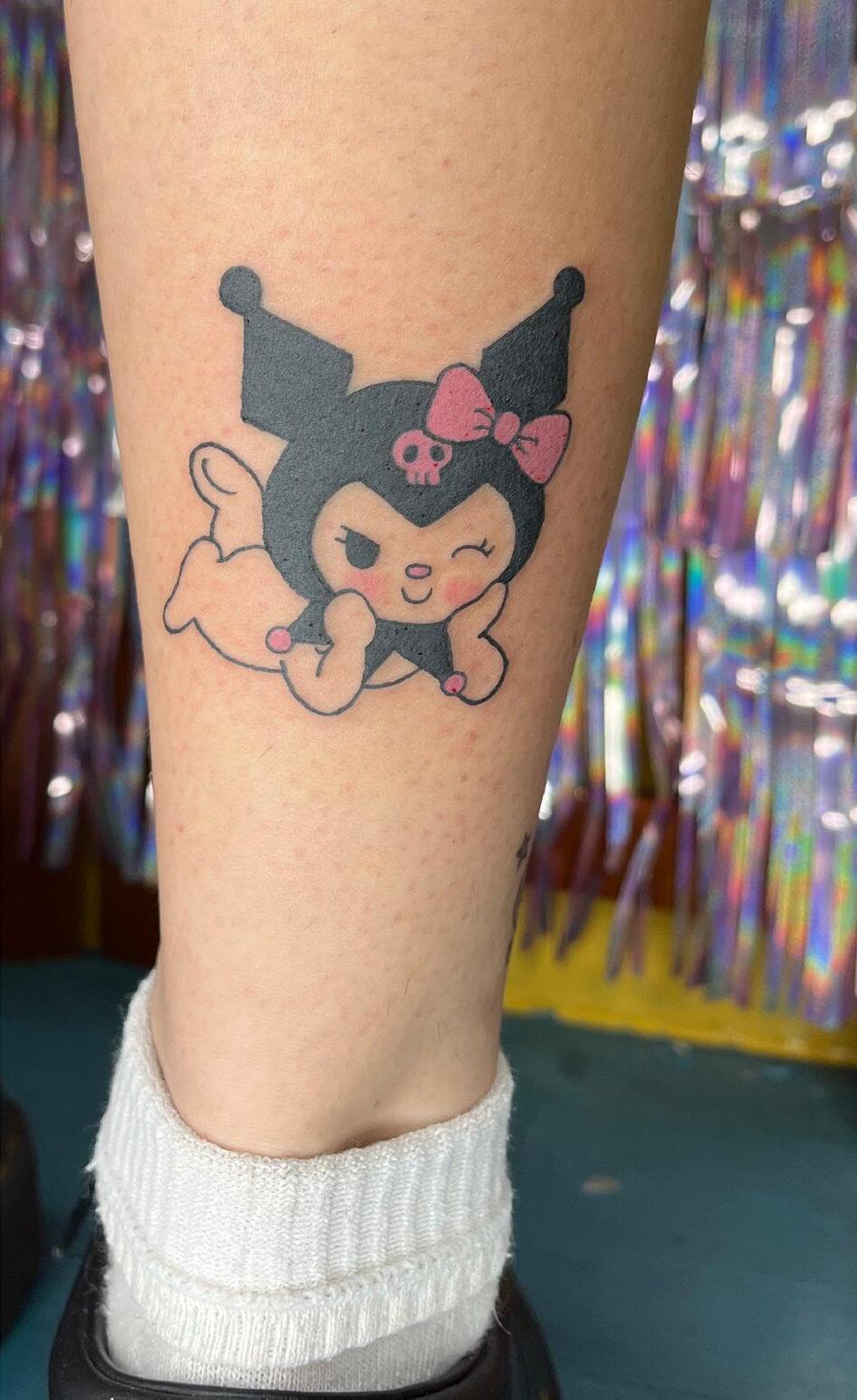
 By. Marjorie Stemmler
By. Kiana Kalahele
By. Marjorie Stemmler
By. Kiana Kalahele
How has the Chapman community dealt with opposing opinions about Israel and Palestine?
By Sarah Hart and Makenna Kunimura
 (From left: Israel protest demonstration in Piazza, collage of Palestine posters by parking garage) Photos by Lisa Wong and Makenna Kunimura
(From left: Israel protest demonstration in Piazza, collage of Palestine posters by parking garage) Photos by Lisa Wong and Makenna Kunimura
Jolina Hamdan, a sophomore who is half Palestinian, has heard stories about conflict in Gaza from her family since birth.
“Palestinians are some of the bravest people in the world,” said Hamdan. “These are real people, who right now, as we speak, are being killed for their ethnicity.”
Edward Lukowsky, a Jewish sophomore software engineering major, has also heard about the Israel-Palestine conflict his entire life, having family who lives in Israel.
“No, I don’t think it’s a genocide. Obviously, there are people dying, and that’s terrible,” said Lukowsky. “But that’s what happens in war. And if [Hamas] didn’t want a war, they should have never attacked.”
This school year, on October 7, 2024, Hamas, a group from the Gaza strip, launched an attack on Israel. In retaliation, the Israeli government launched an all-out attack on the Gaza strip, which is where the majority of what is left of the Palestinian people reside.
The result is bitter, passionate feelings on both sides around the U.S. Especially on college campuses.
Even at Chapman. This contentious topic has created a divisive campus environment for some students. Political campus activism is rare at Chapman, but this issue has brought forth many political demonstrations from both sides. Many passionate students have hosted walkouts, protests, and an encampment on campus in attempts to advocate for university divestment.
Tuesday evening, April 30th dozens of
pro-Palestinian students at Columbia University were arrested after their protests led to the university calling in the New York police. A few days later, a similar protest at UCLA led to more arrests. The Students for Justice in Palestine is running an encampment on Chapman’s campus to continue to push for university divestment, which is the group’s primary goal. It is located between Wilkinson Hall and Memorial Hall.
While Chapman protests on both sides have been more controlled, its students are no less passionate on the Israeli/Palestinian conflict.
Duran Aziz, first year graduate student and executive member of the campus chapter of Students for Justice in Palestine (SJP), is among those upset because it sees Chapman as contributing indirectly to attacks on Palestinians through its business ties.
“I think it’s the responsibility of every other American to know what is going on over there because our government is funding the genocide,” Aziz said. “Our tax dollars go directly towards the killing of Palestinian men and women and children.”
Gina Faris, a third year student who is half-Palestinian, feels that the conflict consumes every waking moment of her life.
“I think about Gaza every single day,” said Faris. “I’m eating lunch I’ll be like, ‘Damn. They don’t have lunch over there.’ I’m sitting here, sleeping in my bed. I’m not scared of being bombed in the middle of the night, but they are.”
She adds how because her family is directly affected by the conflict, she is passionate about advocating for Palestinian justice. Especially considering her grandparents were forced to leave their homes forever.
“My grandmother, she has dementia,” said Faris. “But she remembers her home. That’s one key thing that she always talks about. I don’t think she’ll ever forget fleeing her home.”
Hamdan, an executive member of SJP, has grandparents who were also forced to flee from Palestine. To acknowledge Palestinians whose homes have been taken away or destroyed, SJP put up a “key of return” display in the Piazza.
“Palestinians still have a key to their home and there’s no home anymore, since 1948,” says Hamdan. “That’s what [the key of return] display is about…they hope one day they can go back.”
A look at the pro-Israeli side:
According to senior business major and SSI executive Eli Schechter, Jewish students are the most targeted group on campus.
“The other side [believes] that you should destroy the State of Israel, which is basically calling for the second Holocaust,” said Schechter.

Ellie Metters, a junior creative writing major, feels that those who don’t support Israel are misinformed.
“It’s like [supporters of Palestine] just believe things that are either outright untrue, or out of context, or exaggerated, or misinformed,” said Metters. “And then they see any attempts to challenge them as just further proof that they’re right.”
But some know that both sides have a right to their perspectives.
Shira Klein, chair of the History Department, explains how her heavy heart does not get in the way of seeing the two sides of this issue.
“I am surrounded by people who think differently than me about this issue and I think the key is to always assume good faith.”
- Doctor Shira Klein
“As an Israeli, I’ve been affected by what happened in Israel and Palestine,” said Klein. “This comes from a
Shira Klein, chair of the History Department. Photo by Makenna Kunimuravery personal place. But I am surrounded by people who think differently than me about this issue and I think the key is to always assume good faith.”
“This is peoples’ land and they’re just trying to live there.” - SJP member Hamdan
Still, not every person who has been vocal on campus believes that those with opposing opinions have “good faith.”
“I think that (Students for Just for Palestine) and the people in it are really bigoted,” said a student who requested anonymity for safety reasons. “I can see where they’re coming from, but they don’t understand what’s actually going on. I feel like a lot of them, who would chant ‘ceasefire now’ would also support Iran shooting missiles at Israel.”
“This is peoples’ land and they’re just trying to live there,” says Hamdan. “To be murdered for living there and for your ethnicity when your family has lived there for generations is just so evil.”
Students supporting both sides of the conflict have complained about flyers and flags that they have put up around campus being removed, as well as members receiving threats, hate speech, and being doxxed.
Other students, like Hamdan, feel that what Israel is doing is fundamentally unethical, no matter how you look at it.

Klein reacts to the Palestinian flags that were put up in the Piazza on campus.
“I think that it is wonderful that the students feel comfortable enough to express themselves this way,” Klein said. “[It’s] a sign of a healthy campus culture where students can express their hopes or their concerns or their anger so I think that’s great.”
With tensions building across campus, Dean of Students Jerry Price expressed his responsibility to house a safe environment for passionate students.
“Our first priority is keeping people safe
and when times get tense there’s always a greater chance of some conflict,” Price said. “It’s not uncommon for college students to address or take positions on controversial issues.”
The Office of Public Safety recently sent out an email responding to students who have raised concerns about a pro-Palestine public speaker who was invited to campus by Students for Justice in Palestine named Maya Abdallah.
“Some in our community have expressed that they feel adversely affected by the upcoming event and feared for their safety,” reads an email from the Office of Public Safety. “The views expressed by the speaker may be deemed controversial and abhorrent to some in our community. You can contact Public Safety if you have a concern about your safety.”



Some students found the email to be insensitive, which provoked a negative response from pro-Palestinian students.
“It was definitely disappointing to see that, but not surprising,” an anonymous student said. “It’s just funny when there have been other speakers who have been more inflammatory and have actually said very terrible things, and they still had no response to that.”
Another student felt anger, and expressed that they think there needs to be stronger action taken to let administration know that the email was not in the best interest of students of
(From top: Israel display, Palestine protest at Dodge) Photos by Lisa Wong and Sarah Hart
color on campus.
“I feel like we need to make ourselves known on campus and show students, faculty, and administration that their black and brown students care about these things,” they said. “Their Middle-Eastern students care about these things.”
Students aren’t the only ones who feel the email was a misstep.
“It’s a bad situation all the way around,” Price said. “Normally we wouldn’t send that…It was not a public safety decision to send it, it was a larger university leadership decision. Normally we wouldn’t do anything like that but in this case, we received such a high volume of concerns.”
With situations like this, there are instances that involve harassment on campus. According to Price, there’s a line between harassment and disagreeing with someone.
“If they are being harassed then we wanna know about it,” Price said. “Not everyone has the same opinions on what being harassed is. If students are just being critical, voicing that criticism in itself is not harassment. Unwanted communication certainly could be harassment.”
For the foreseeable future, the main objective of Students for Justice in Palestine is for Chapman to divest. But what is divestment?
“We…are calling for a complete and total divestment from all weapons manufacturers and institutions that aid in the occupation of Palestine,” reads a pinned post on the Chapman chapter of Students for

Student apart of Students Supporting Israel wearing Israel shirt. Photo by Makenna
Justice on Palestine’s Instagram page. “This includes but is not limited to, Aruba Networks, Lockheed Martin, and the Boeing Company.”
The aforementioned companies all supply Israel with technology, money for military equipment, or military equipment itself.
Another anonymous student involved in Students for Justice in Palestine attests that Chapman’s choice to invest is unjustifiable no matter what side you’re on.
“To hear that some of the money, either from donors or students is going towards companies that help war and genocide, its inexcusable and unacceptable,” they said. “No matter where you are on the spectrum of politics, I think we can all agree that educational funds should not be used towards war or violence.”
KunimuraIn terms of Students in Support of Israel, their primary objective is to support students who identify as Zionists. Zionism is the belief that states have the right to self-determinate, which is what Israel is doing.
The only work we do is support the ethnic Zionist students on campus,” said Schechter. “[Zionism] is the belief that the State of Israel should exist.”
Across the country, university students have set up encampments in order to push for university divestment. Notably, Chapman’s neighbors, UCLA, USC, and UC Irvine, all have active encampments.
As for Students Supporting Israel, members regularly post flyers around campus, and recently hosted an event inviting Israeli soldiers to campus to speak.
As the semester ends, it is clear that the conflicts brought to campus by the deaths on both sides in Gaza is not unique to Chapman’s campus, nor will it be resolved on Chapman’s campus alone.



 (From top: SJP key of return display, SSI baby crib display) Photos by Nicole Kavros and Lisa Wong
(From top: SJP key of return display, SSI baby crib display) Photos by Nicole Kavros and Lisa Wong
 By Kiana Kalahele
By Kiana Kalahele
Traveling to Vietnam for a Study Abroad course was supposed to have been a fun trip for Jessica Miyasato. But after returning to California with a high fever—courtesy of a monkey bite—and a bad case of jetlag, Miyasato could only think about one thing.
And it didn’t have to do with getting better.
“I was more worried about missing my class the day than I was about the strange monkey that bit arm,” Miyasato, a senior business administration jor said. “I didn’t even go to a hospital to get (the checked out.”
She made it to class. If only all students were that dedicated, right?

Now more than ever, students are missing class, meaning there are more empty seats than occupied ones in classrooms.
or simply, because they didn’t want to go.
Chapman is no exception.
“I always try to go to class because I feel guilty if I don’t,” said Miyasato. “But, a lot of the time, I notice that at least three or four kids in each of my classes are always absent.”
Currently at Chapman, there is not one specific attendance policy that the entire student body is required to follow. According to the course catalog, the university’s attendance policies are determined by each professor and are included in the course syllabus that is distributed at the beginning of each semester.
However, the university has made suggestions on what they deem to be “good attendance.”
“The university recommends as a minimal policy that students who are absent 20% of a course should be failed,” the catalog stated.
Illustration by Sukhman Sahota the next bit my administration ma(the bite) that
But not all Chapman students would have followed her example.
Following the COVID-19 pandemic, chronic absenteeism in schools across the U.S. has risen to 26% as of 2023—up 15% from before the pandemic—with both students and even teachers missing classes due to sickness and illness, academic conferences and trips, personal issues, or
Additionally, Chapman believes that students who don’t attend the first class of a course in which they are registered may be dropped. The only exception would be if arrangements with an instructor were made prior to the first day of class.
However, even with these policies
Jessica Miyasato was on her Study Abroad trip when she was bit by a monkey, but she still made it her mission to go to class. Photos courtesy of Miyasato


in place, the university doesn’t have much jurisdiction when it comes to punishing students.
Instead, the punishment is left up to each individual professor.
Senior computer science major Alexa Zuch has noticed how relaxed attendance policies have become in her classes, especially following the pandemic.
“There are some professors who do really care about students coming to class, but there’s also the latter,” said Zuch. “Those are the professors who don’t even bat an eye when half of their class is missing.”
In many of Zuch’s classes, her professors do allow at least one or two excused absences per semester. But, according to her, there doesn’t seem to be any intense consequences if a student were to miss more than the allotted amount.
“I do notice when students miss class, but I try not to let it affect me (or my teaching) too much because if students don’t want to show up, that’s on them,” said assistant professor of psychology Amy Moors.
While Moors does have an absence policy outlined in her course syllabus, there’s only so much she can do to make students adhere to them.
“I allow students two excused absences as long as they communicate with me beforehand,” she said. “But, I don’t follow up with them if they don’t email me.”
She is grateful for those of her students who do make it their mission to attend all class sessions or send an email detailing an absence.
“It makes sense that my higher-performing students are the ones who come to class frequently,” she said.
However, not only are students missing out on learning, but they are also losing out on money by skipping classes.
According to College Info Geek, skipping class means losing out on part of the money that you are paying for your college tuition. At Chapman, tuition is currently $32,290 per semester. Hypothetically, if a student is taking five classes with each class equaling three
credits, this would mean that each three-credit course they are taking costs roughly $6,458.
To break that down even further, there are around 34 class sessions per semester at Chapman, with a focus on classes that meet twice a week. This would mean that each individual class session costs roughly $190 of a student’s tuition.
Therefore, each time a student misses class, they are losing out on almost $200 of their tuition money.
Zuch explains that she’s heard all types of excuses from her friends who have missed class. Sore stomach. Going to a concert or festival. An “emergency.” They had to take their dog to the vet. They didn’t finish their homework and decided to skip. Or the most common one: They just didn’t feel like getting out of bed and making the long trek to class.
“After the pandemic, it almost feels like everyone’s relationship with school has become optional, including mine.”
- Senior Alexa Zuch
Mental health days have become a common trend among students—-both in high school and college—where they’re able to take the day off to rest, recharge, and prevent burnout from the overwhelming stressors that come along with school.
Orta—who is a full-time student, has an off-campus job and is also involved in two student organizations— is no stranger to mental health days.
“I take days off from school a lot because it helps me recover from the busyness of everyday life,” she said.
Even with taking some days off of school, Orta does understand that it is important not to take advantage of too many absent days.
“I have skipped class before by saying (to my professor) that I had a stomach bug, when in reality, I was driving to the LAX airport to pick up my friend,” she said. “But I don’t abuse these excuses too much because if you aren’t going to school at all, how will you ever learn anything?”
During the 2022 to 2023 school year—-which was Chapman’s first year back to in-person classes following the pandemic—-many students would use the excuse of ‘having COVID-19’ in order to get out of going to their classes. According to the university, the abuse
“I’m much more willing to take mental health days or personal days now than ever before,” Zuch continued.
And, students including senior screenwriting major Alesia Orta, say it does more help than harm.
 Alexa Zuch has heard tons of different excuses from her friends for skipping class. Photo courtesy of Zuch
Alexa Zuch has heard tons of different excuses from her friends for skipping class. Photo courtesy of Zuch
of students requesting unnecessary doctor’s notes continued to worsen to the point where Chapman’s Student Health Center decided to make doctor’s notes not as easy for students to receive.
According to Jacqueline Deats, the director of the health center, students were only able to receive notes from the center if it was deemed “absolutely necessary” by a medical provider.
“During the pandemic, we didn’t want any students to go to class if they were having COVID-19 symptoms, and therefore, a lot of notes were given out to students,” Deats said. “It became very complicated trying to decipher who really needed a note.”
However, students, including junior business administration Kaylin Li, who weren’t abusing the ‘COVID-19 excuse’ were anything but happy with the rule.

“It was hard for me because I would actually be sick with a fever and I would tell my professor or tell the health center, and they wouldn’t believe me,” Li said.
To many students’ relief, the rule was revoked once the year ended, making doctor’s notes for those who needed them more accessible.
For the current school year, professors are still able to request doctor notes from students for absences related to sickness if it’s outlined in their course syllabi.
“I’ve never had a professor this year who has demanded doctor notes when we’re sick, but some of my friends haven’t been as lucky,” Miyasato said.
While there isn’t one fixed method for addressing absences at Chapman, the university’s COVID-19 policy is a different story.
Chapman’s COVID-19 policy was recently changed on March 1 to reflect new updates in accordance with the Centers for Disease Control and Prevention (CDC) guidelines.
The main update: Removal of the five-day isolation period for those who contract the virus.
“Removing the five-day isolation period does not increase community transmission,” said Jeff Goad, who serves as the inaugural chair of Chapman’s School of Pharmacy. “We’ve seen through computer modeling systems that there is no difference in community spread with or without the five-day isolation period.”
Students are able to go to Chapman’s Student Health Center to receive doctor’s notes. Photo courtesy of the health center’s website
According to Goad, over 50% of COVID-19 transmission takes place among people who show no symptoms.
The updated COVID-19 policy emphasizes the university’s commitment in working to revert back to how classes were being run before the pandemic.
However, this could pose a struggle for some professors who have been canceling classes or using virtual classes to their advantage.
Chapman LGBTQ+ studies professor Liz Martinez believes that some professors are more susceptible now than ever before to cancel classes because they don’t think that students care.
“It can be a bit discouraging coming to class ready to teach (the students) and then seeing that almost half of the class is missing,” Martinez said. “I think it discourages professors to the point where some of them don’t even see the need to have classes in-person or have them at all.”
While some students have been disengaging from their classes, so have some professors, citing professional burnout and other personal responsibilities as their reasons.
“Professors undergo problems just like students that can make it hard to be able to make it to every single class,” they said. “I try my hardest to make sure that I am always there, but I know for some of my colleagues, it can be a bit overwhelming with just everything else going on.”
Upon receiving a message from a professor stating that class has been canceled for the day, some students jump with joy. It gives them time to rest,

catch up on homework, or hit up the mall or the beach for the day.
But for others, not so much.
“It just seems like a waste of my tuition and time if I am signed up for a class that just ends up getting canceled most of the time,” said Li. “At that point, it makes me wonder if college is really worth the money you put in.”
While Chapman’s policies on absences may not be getting changed any time soon, Miyasato believes that it’s still very important to keep attending classes—even when you don’t feel like it.
Not just for your own learning, but also to make use of that $32,290 tuition fee.
“Not everyone may like school or may have things going on in their lives that make it more difficult to go, but you have to try,” said Miyasato. “Without trying, it could just end up hurting you more in the long run.”
Kaylin Li has her frustrations with her fellow classmates using COVID-19 as an excuse to skip class. Photo courtesy of Li


Covering her mouth, trying not to gag, freshman Kendall Nelson was petrified seeing black mold living between the cracks and crevices in the comfort of her Henley Hall dorm room.
“When I first saw the toilet mold it was game over,” Nelson said. “I literally had to take a
deep breath and walk away because it was so bad. I avoided our bathroom for a whole day after.”
The freshmen living in the dorms are feeling uncomfortable seeing mold growing in their showers, on toilets, and on surfaces. Students are claiming to obtain illnesses
from the mold that are worrisome to their future health. Some of the oldest dorms, Pralle-Sodaro Hall and Henley Hall, have shown the most grievances from students regarding mold issues.
Administration officials say they are doing the best that they can to resolve such issues. But some students think they could be doing better.
Stepping foot into Pralle-Sodaro Hall and Henley Hall today, there are occasionally rooms under repair for mold issues. But recently workers were also coming in and out of Pralle-Sodaro Hall from a recent flood that required some students to move out into houses near campus.
Freshman TV and film production major Annsley Helenhouse is currently a resident in Pralle-Sodaro. She’s fearful that the black mold living upon her and her roommates could possibly lead to more than just a cold.
“The mold is definitely affecting our physical health,” said Helenhouse. “All of us got really sick in the room. It’s not like a normal sickness like the flu where you could take medication and it just goes away. This could have an everlasting effect which makes me really uncomfortable.”
Dean of Students Jerry Price thinks students are too quick to assume where their sickness is coming from.
“I think students assume since there’s grimey stuff in the air conditioner and then they’re feeling bad, it must be caused by the mold,” Price said. “Students see two
things juxtaposed to each other. It’s hard medically to prove your condition came from this thing.”
When first coming to Chapman, students get assigned to live in one of five of the available freshman dorms on campus. To most students, it’s obvious which ones are older and newer.





“Having experienced living in Henley and Sandhu, Sandhu is significantly nicer than Henley or even Pralle,” said Katrina Gillette, freshman strategic communications major. “You can tell Henley is older. Sandhu actually has floor space instead of just three beds all side by side like a prison.”
Henley Hall resident Becky Alonso, freshman business major, shared her second moving experience of the semester.
Flyer to encourage students to fill out a work order with any concerns. Graphic by Makenna Kunimura
“My Henley roommate informed me about something growing in our bathroom,” Alonso said. “We submitted a work request. They said mold was growing and moved us into Sandhu for a month. They tore down the walls of the entire bathroom and put up new walls. The whole move out process was a hassle.”
Alonso isn’t the only one who had to move out.
“Due to mold, my roommates and I last year were moved to a house for about two weeks,” said Brooke Bettencourt, sophomore theater major.
Living in such tight proximity, mold growth and sickness is inevitable.
“It’s definitely unsettling how close to each other we live,” Gillette said. “If the mold causes sickness, and one person is sick in the room, then everyone in the room is sick.”
With these concerns, administration is working hard in efforts to meet students’ needs.
Juan Tinoco, assistant dean of Students, Residence Life and First Year Experience, expressed that the Resident-Life team makes it their top priority to make sure students are getting the attention they need for safety concerns regarding mold in the dorms.
“I did not fill out a work order for our mold because I was too scared they were going to move me out of my dorm room.”
- Freshman Savannah Frederick
“I would encourage any students concerned of any micro growth to submit a work order,” Tinoco said. “Any time we get a concern about micro growth, we send our project managers to get eyes on it, and send our industrial hygienists to assess it so we can deal with it as soon as possible because our top priority is to keep our students safe.”
Mold growing in a Pralle shower. Photo courtesy of Annsley HelenhouseWhen students have a concern or need something fixed in their dorm room, they are required to fill out a work order form that states what kind of service they need. Yet, some students choose to ignore their problems.
“I did not fill out a work order for our mold because I was too scared they were going to move me out of my dorm room,” said Sandhu resident, Savannah Frederick, undeclared freshman.
While work orders pile up from the freshman dorms, some go unseen.
“I think work requests are good but sometimes they don’t even go through,” Alonso said. “I submitted one and I didn’t get the help I needed. Especially when it’s mold I think sometimes they don’t see it as much of a problem as it should be.”

Others complain too.
“We contacted the admin and we submitted a form for the mold but they never came,” Helenhouse said. “So we had to get our parents involved and then eventually they came. A lady came and said there’s nothing she could really do.”
Despite these issues, some students who live in Glass Hall have not yet experienced this infamous mold.
“My roommates and I have not had any mold in our dorm here in Glass,” Madalynn Chernoh, communications major said. “A lot of people in Pralle and Henley have mold. I feel like there’s mold in the walls in Pralle and Henley because walking in, it smells like cat pee.”
 (From left: Pralle housing worker working on construction, Henley shower walls being replaced) Photos courtesy of Annsley Helenhouse and Becky Alonso
(From left: Pralle housing worker working on construction, Henley shower walls being replaced) Photos courtesy of Annsley Helenhouse and Becky Alonso
Some dorms are older than others but overall, the administration thinks that they are still up to par.
“I do think the dorms are worth what students are paying,” Price said. “I think we have an excellent first year experience, some are older, some are newer.”
Some students don’t agree.
“I don’t think the dorms are worth what we are paying,” said Frederick. “I think we are paying a lot of money for such small rooms and they are gross because they have mold. It would be one thing if just one room had mold, but there’s so many.”
Students expressed what Chapman should be doing differently.
“I think the workers should be doing room checks every once in a while,” Frederick said. “They should be giving us more resources to be aware of how to prevent mold.”
Glass Hall resident Michelle Correa, freshman business major shares advice for people with mold in their dorm rooms.
“If you don’t have your fan on after you shower it can definitely make mold grow in the bathrooms,” Correa said. “Since there’s no windows in the bathrooms, I say use the fan as much as possible.”
Students are hoping that next year’s freshman class gets a cleaner and more cooperative experience. Until then, Resident-Life shares tips on how to avoid mold growth.
“I call these the three C’s to help prevent micro growth,” Tinoco said. “Cleanliness, climate, and communication.”

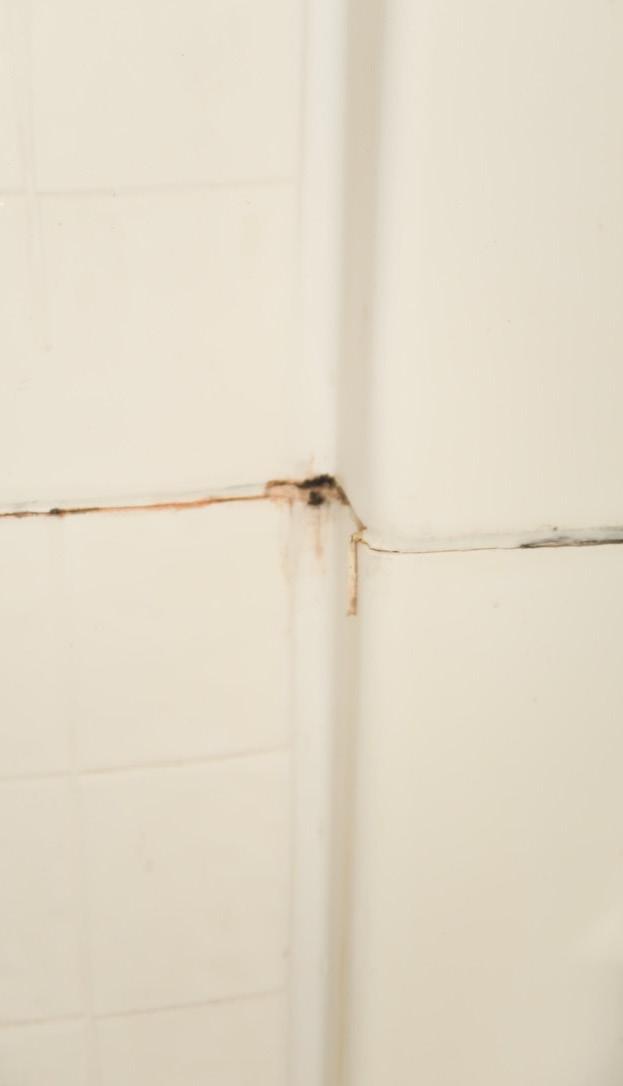 Mold growing between cracks of a Pralle shower. Photo by Makenna Kunimura
Mold growing between cracks of a Pralle shower. Photo by Makenna Kunimura




advice to avoid mold growth. Photo courtesy of Chapman University

 Chapmans
Chapmans

Remember a time when watching a new movie was an event: a trip to the theater with buckets of extrabuttery popcorn, a gigantic bubbly drink, and the beautiful sound of Dolby Atmos surround systems?
Then came the Big Bang of the film industry.
Streaming platforms.
“There’s less enthusiasm to get in your car and go spend $17 on a movie,” said Quinn Haba, a freshman studying creative producing.
The film industry is in an era where movies are often put on streaming platforms just weeks or months after a theater release — or sometimes even in conjunction with its premiere.

The average student is just more likely to lean into the accessibility and ease of watching their content on one of these media services.
“You’re not changing the world like you used to.”
-Freshman Quinn Haba
Haba wanted to work in the film industry to team up with talented people and watch his creative visions come to life. He can’t help it if now, with the overwhelming amount of content being marketed to consumers through streaming, his work never sees the light of day.
“It’s overwhelming for an audience to watch everything, so your work might not be recognized,” said Haba. “You’re not changing the world like you used to.”
It’s a sad reality for nostalgics. Sitting on your couch just doesn’t have the same
The days of going to the movies are fading away. Studies have found that only 43% of participants reported going to a movie theater between July 2021 and July 2022.
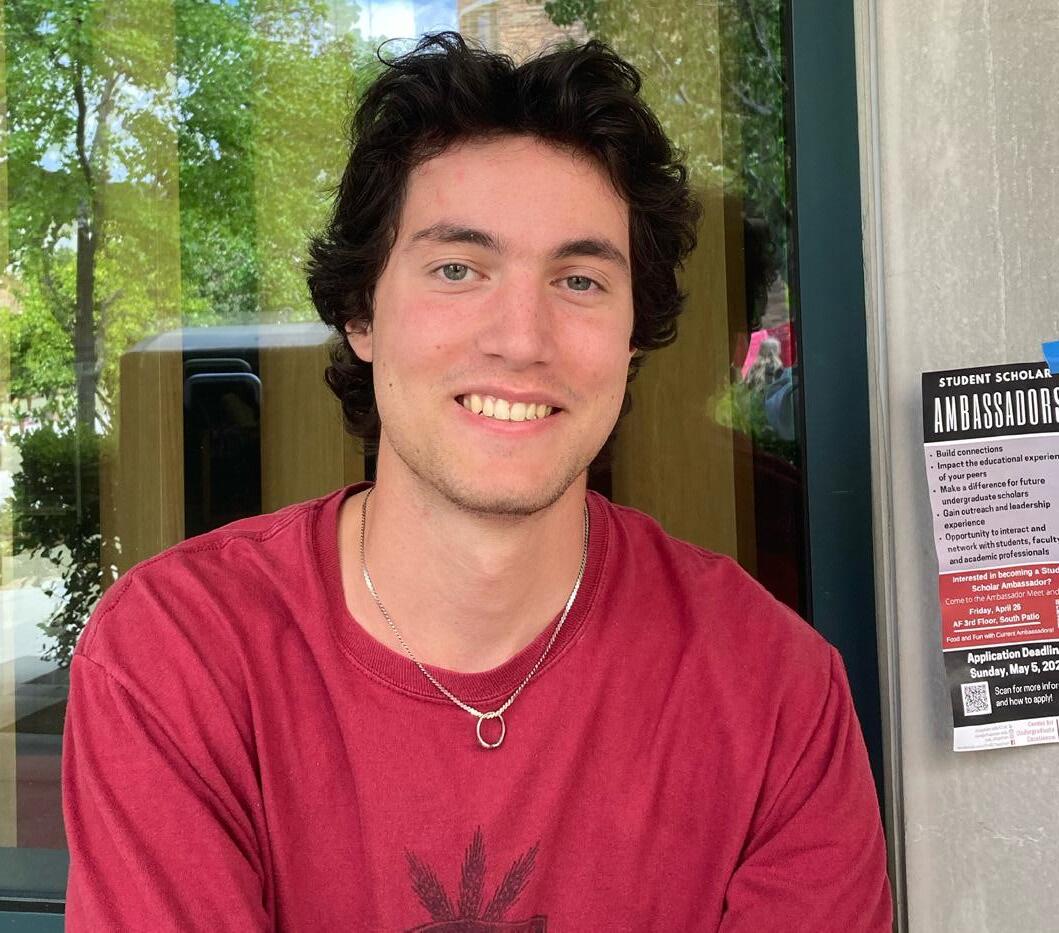
 Freshman Quinn Haba sees the difference that streaming services have made in the film industry. Photo courtesy of Haba
Illustration by Sukhman Sahota
Freshman Quinn Haba sees the difference that streaming services have made in the film industry. Photo courtesy of Haba
Illustration by Sukhman Sahota

effect as the smell of popcorn and the glow of the silver screen.
Fred Bancroft, a sophomore majoring in writing for film and television, prefers to watch his movies for the first time in the old fashioned way — in theaters.
“Going to the movies is superior,” said Bancroft. “It’s a full experience. It’s immersive.”
People still love going to the movies, Haba and Bancroft are just a few examples of modern-day movie buffs.
But in a poll answered by Chapman students, more than half said that they prefer to wait until a new movie comes out on a streaming service to watch it for the first time.
“I haven’t found a need to go to movie theaters,” said sophomore political science major Brandon Mahgerefteh. “Most popular mainstream movies release on streaming the same day, or right after hitting theaters.”
Mahgerefteh isn’t a fan of the costs that usually come with a trip to the movies.
“I don’t see a point in wasting $20 to sit in an uncomfortable, dirty movie theater chair that they never clean,” he continued. “And to get a cup of water or soda, it costs more.”
It’s not exactly cheap to subscribe to a streaming service, either. Netflix’s highest subscription — premium — costs $22.99 a month. Fortunately, the services usually offer more affordable options as well. Netflix’s standard with ads subscription is $6.99 a month, and Hulu offers a $1.99

 Sophomore Brandon Mahgerefteh doesn’t see a point in going the movies rather than watching media on streaming. Photo Nicole Kavros
Sophomore Brandon Mahgerefteh doesn’t see a point in going the movies rather than watching media on streaming. Photo Nicole Kavros

deal for college students.
“Movie theaters are becoming almost extinct, which breaks my heart.”
-Professor
Viewers would argue that this is roughly more wallet-friendly than the price of a casual movie theater outing.
Which poses the question: Is it worth it to buy a streaming subscription and ditch the theaters altogether?
More than half of Chapman students answered in a poll that they are currently subscribed to more than four streaming platforms. 19% of these students subscribe to six or more services.

behind the scenes of this new form of media consumption. A limited series that she produced called 10 Days in Watts was released for streaming on PBS SoCal last year.

“Most people don’t want to pay $18 to see a show, and then park, and get your popcorn, and your candy,” said Saga Elmohtaseb, a professor at the Dodge College of Film and Media Arts. “When you stream something, everyone can watch at home.”
Elmohtaseb is familiar with the
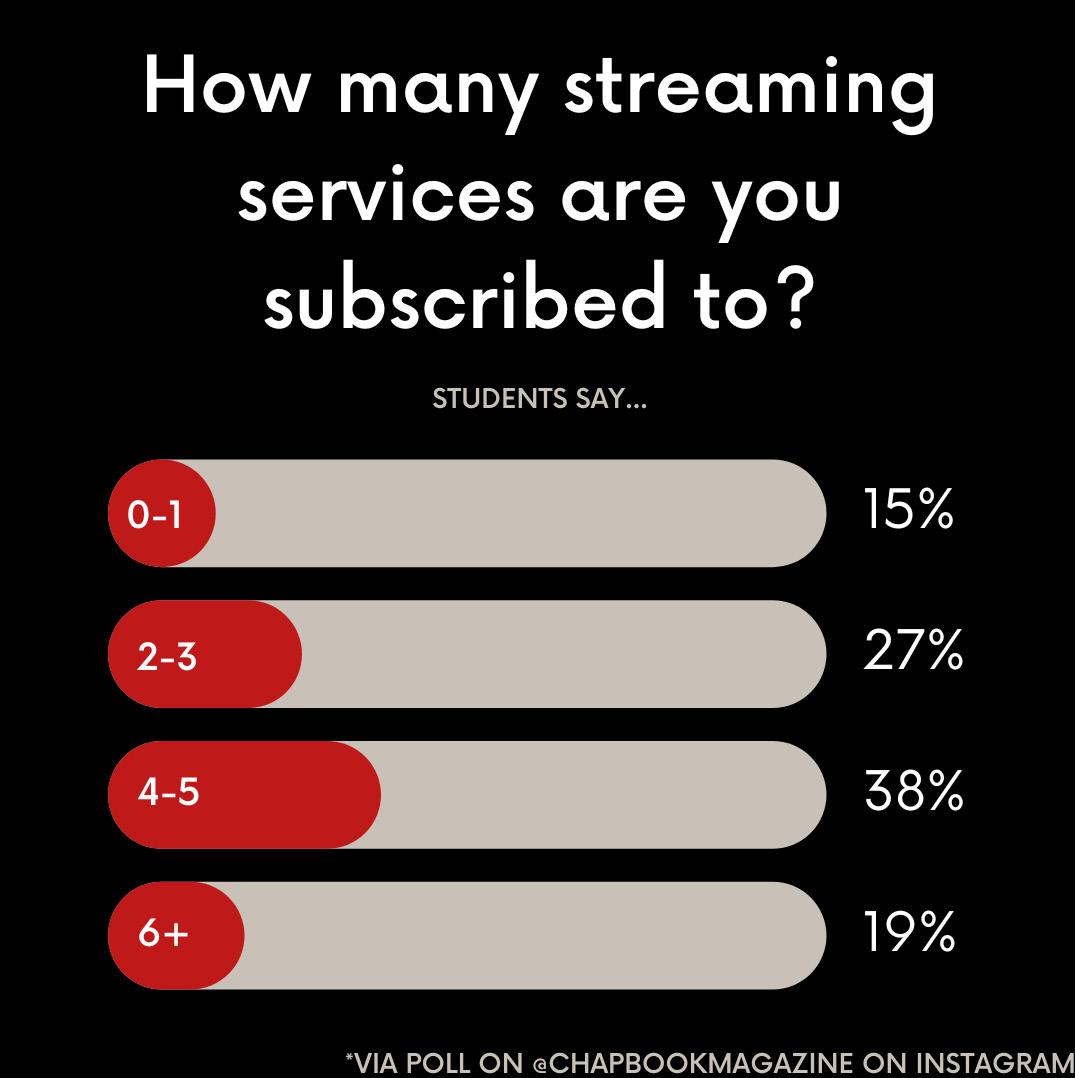
“There’s more quantity over quality. It’s the weirdest, most interesting thing ever.”
-Sophomore
“We did [10 days] on PBS, which has 21 million subscribers a month,” Elmohtaseb said.
them. Even cinephiles like Elmohtaseb know that streaming is more accessible.
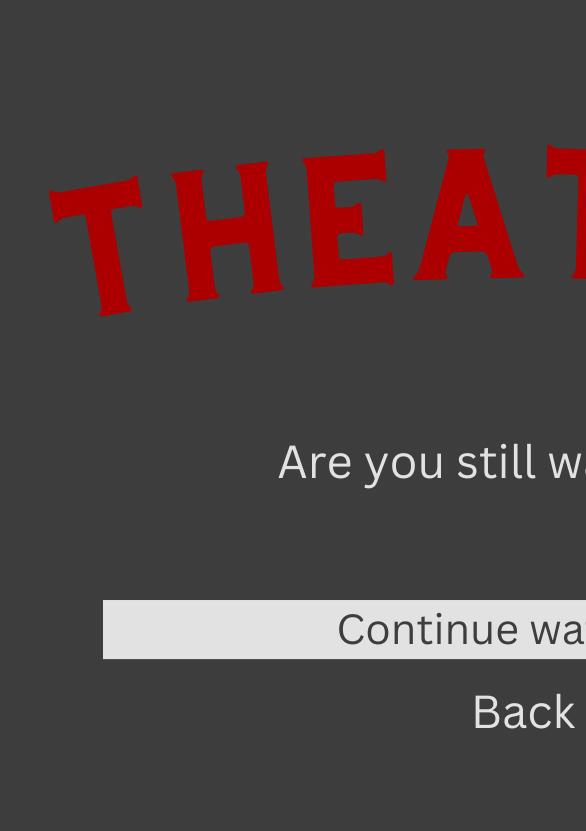
“Viewership is currency. Once it’s out in the

world, it’s how the content generates nonmonetary revenue.”
Times are changing, and the ways that we consume content are changing with
“Movie theaters are becoming almost extinct, which breaks my heart. They can’t sell tickets for the theaters,” Elmohtaseb said.
“Soon enough, that flick will be streamed.”
Riley Foulk, a sophomore creative producing major, estimates that his family holds active subscriptions for around six to eight different platforms.
“There’s the biggest content overload. That in itself is detrimental to the medium, because people enter a state of content purgatory. You’re in a position where you have so much content to watch, so you’re like, ‘What do I do?’” said Foulk.
uNoGS, a website dedicated to listing all movies and series available on Netflix in each country, states that Netflix has just under 6,700 options for watching movies or TV.
With several different platforms on the
Sophomore Chris Perazzo prefers to watch movies in theaters because of the viewing quality. Photo by Nicole Kavros A streaming-themed take on the Graphic by Nicole
market (Hulu, MAX, Disney+, Amazon Prime, ESPN+, and Paramount+, to name a few) there’s what feels like an unlimited supply of content for the average consumer. Even the most dedicated viewer couldn’t possibly watch it all.
“The backhand is that while there’s so much cool stuff, there’s more quantity over quality,” continued Foulk. “It’s the weirdest, most interesting thing ever.”
Sophomore animation major Chris Perazzo could stay at home and watch content until his eyelids grow heavy and the screen asks “Are you still watching?” He could never go to the theaters again. Him and his friends could order DoorDash and watch the newest Marvel movie from the comfort of their couch, and the whole experience would cost less than a singular movie ticket.
But it’s the experience — the “indescribable feeling we get when the lights begin to dim,” as actress Nicole Kidman says in her iconic AMC Theaters ad — that makes it worth it for him and so many other students.
“For Spiderman: No Way Home, I saw it in
theaters four times. I’ve never seen it on streaming, because I think that watching is a better experience in theaters,” said Perazzo.


Sometimes, the movie itself isn’t what draws him to the reclining seats and lit-up marquees. It’s the magic of the theater.
“I feel like movies right now are pretty dry, there’s nothing really interesting,” he said. “But I get more excited to watch them because I can see them in theaters.”
What has been deemed “The Streaming Wars” in popular culture is the influx of new services. Graphic by
 the classic Netflix screen.
Nicole Kavros
Nicole Kavros
the classic Netflix screen.
Nicole Kavros
Nicole Kavros
 By Sarah Hart
Huntington Beach residents hold a 50 ft pride flag at the city’s pier in lieu of a city-wide ban on pride flags. Photo by Sarah Hart
By Sarah Hart
Huntington Beach residents hold a 50 ft pride flag at the city’s pier in lieu of a city-wide ban on pride flags. Photo by Sarah Hart
During Kari Lien’s first week as a creative writing major at Chapman in 2020, a student came into a class intoxicated, and started yelling hate speech about mem-
Danielle Jagiello, a Huntington Beach resident, holds a pride flag at a march for the death of Nex Benedict. Photo by Sarah Hart
bers of the LGBTQ community.
As a non-binary student, Lien was incredibly uncomfortable.

To make matters worse, around that same time, students began to receive emails from P-Safe which talked about a local Nazi group that had been posting recruitment flyers on campus.
“There was a lot of culture shock happening for me…‘I was like, ‘What did I just get myself into?’ said Lien. “It was freaking me out so much, I couldn’t leave my room. I was just so scared.”
While Lien isn’t alone in their experience, many other queer students feel as though the safety issues that they may face on campus are not as extreme as what Lien experienced. Still, queer students can feel that the general environment may not be as LGBTQ friendly as they would like.
While the majority of Chapman students are relatively removed from the conservative environment of Orange County on campus, some queer members of the Chapman community still feel as though there could be a stronger sense of connection between the queer communities of Chapman and Orange County.
Chapman campus is surrounded by Orange County, a conservative area.

While some students, like Lien, feel as though conservatism is prevalent on campus, others feel that Chapman is safe, for the most part.
“I’ve heard there’s a lot of homophobia in Orange County, but that’s it,” says Rebecca Greenwood, a junior majoring in documentary filmmaking. “I think it depends on who you interact with.”
Greenwood added that she feels there is a difference between certain disciplines. Especially between her film classes and classes for her GE requirements.
“In Dodge as a whole I feel like everyone is pretty accepting, that’s where I am the most,” said Greenwood. “There’s definitely been times I’ve been in class… where you can tell that the students are just less exposed to diverse people.”
In terms of Orange County, many students aren’t as aware of local politics outside of campus.
“I’m from rural Wisconsin, so [Orange] is like



Joshua Liashenko is the director of LGBTQ studies at Chapman. Photo courtesy of the Chapman website

Stickers and prints available at Fem Queer Fest, a LGBTQ studies event. Photo by Marjorie Stemmler
home, but California-flavored,” says Jade Watson, a senior majoring in Anthropology. They go on to admit that they know very little about any legislation that has been passed locally.
Valentine Chung, a junior majoring in socioloology, also expressed that she doesn’t know that much about Orange County politics, despite having technically lived in the city of Orange for three years.
“I’m not a California voter, because I’m from out of state,” said Chung. “So I feel like I don’t really keep up with any of the legislature here, even though I probably should.”
According to Dr. Joshua Liashenko, director of the LGBTQ studies program, this is normal for a college campus like Chapman.
“Frankly, I feel like there is a disconnect with the information that’s happening in the news and how it impacts folks on campus,” said Liashenko. “Oftentimes college campuses, especially when it’s Orange County, become bubbles.”
Despite the campus feeling relatively safe to queer students, instances of LGBTQ hate is commonplace in Southern California. Considering that the area has historically been a haven nia. Considering that the area has historically been a haven for white supremacist groups, there has recently been an array of anti-LGBTQ legislation being passed within the last year.
In Huntington Beach, the city council recently voted to ban the flying of pride flags at public buildings, including government offices, the civic center, and in public schools. The council is also moving to privatize the city’s library, in efforts to ban books.
In Murrieta School District, just south of Orange County, the school board is aiming to maintain a forced-outing policy, despite a state order to remove the policy on grounds of discrimination. The policy being held up would mean that if a student in Murrieta School District is suspected to have a “change in gender identity” while on school property, the school would be obligated to report it to the student’s family.
For queer college students born and raised in Orange County, things are a different story.
Orange County residents gather at the Huntington Beach pier for an event organzied by Pride at the Pier. Photo by Sarah Hart


“It’s just concerning, because people don’t know that their rights are being taken away,” says Meschuk, a sophomore majoring in anthropology at UC San Diego. “I want people to look it up. But at the same time, if they don’t know, then they’re not going to.”
According to LGBTQ Studies professor, Liz Sanchez, there is a reason that there is a lack of strong queer activism in Orange County. Learning about social issues and queer history can be daunting.
“It’s hard because I know it can be traumatizing to read about these things over and over and over again. But to be complacent, to ignore it, I think can just be as harmful,” said Sanchez. “And something that I see often as a queer educator, a lot of young folks [are] not investing into queer studies and queer politics.”
Meschuk adds that they have noticed that many students who come from out of state to southern California don’t realize that there are real issues affecting marginalized groups in the area due to the assumption that California is a politically liberal place.
“Being by the beach is not going to protect you from homophobia or transphobia!” said Meschuk. “Unfortunately, it’s still going to be there. It’s just going to be dressed up in a different way.”






Kate Meschuk is a queer anthropology student at UC San Diego and aspiring activist. Photo courtesy of Meschuk
- UC San Diego Sophomore Kate MeschukLiashenko had a similar observation.
“There is this perception around the country that California is a haven for LGBTQ people, and in parts of the state, that is absolutely true,” said Liashenko. “However, there are a lot of people here in California, with a lot of different regions, with a lot of different interests.”
Meschuk often attends rallies and protests against anti-LGBTQ legislation in Orange County, and keeps up with city council meetings in Huntington Beach, their hometown. However, they understand that it’s difficult for college students to be active in politics because Meschuk struggles with it themself.
“We just need to be more proactive with organizing, and trying to find ways to connect queer people on college campuses to organizations outside of campus,” said Meschuk. “But then there’s always the problem of well, how do we do that?”





Meschuk adds that apart from the fact that they are only 20 years old and do not have the resources to organize, they are very busy as a full time student.
Liashenko agrees that encouraging a connection between the queer community within Chapman, a college campus, and the greater queer community of Orange County is a good idea.
“I think there needs to be more education concerning how the queer community here at Chapman interacts with the queer community beyond our campus,” said Liashenko. “Getting our students more engaged in the community around us in Orange and also broader Orange County could be a really great way to expand that.”
On the other hand, there is still the issue of a lack of accessibility to queer spaces and resources for the average student.
“Orange County…has few and far between queer spaces,” said Liashenko. “There is - Director of LGBTQ studies Joshue Liashenko

Liz Sanchez is a professor of queer studies at Chapman and has been active in activism in Orange County for a decade.
Photo courtesy of the Chapman website
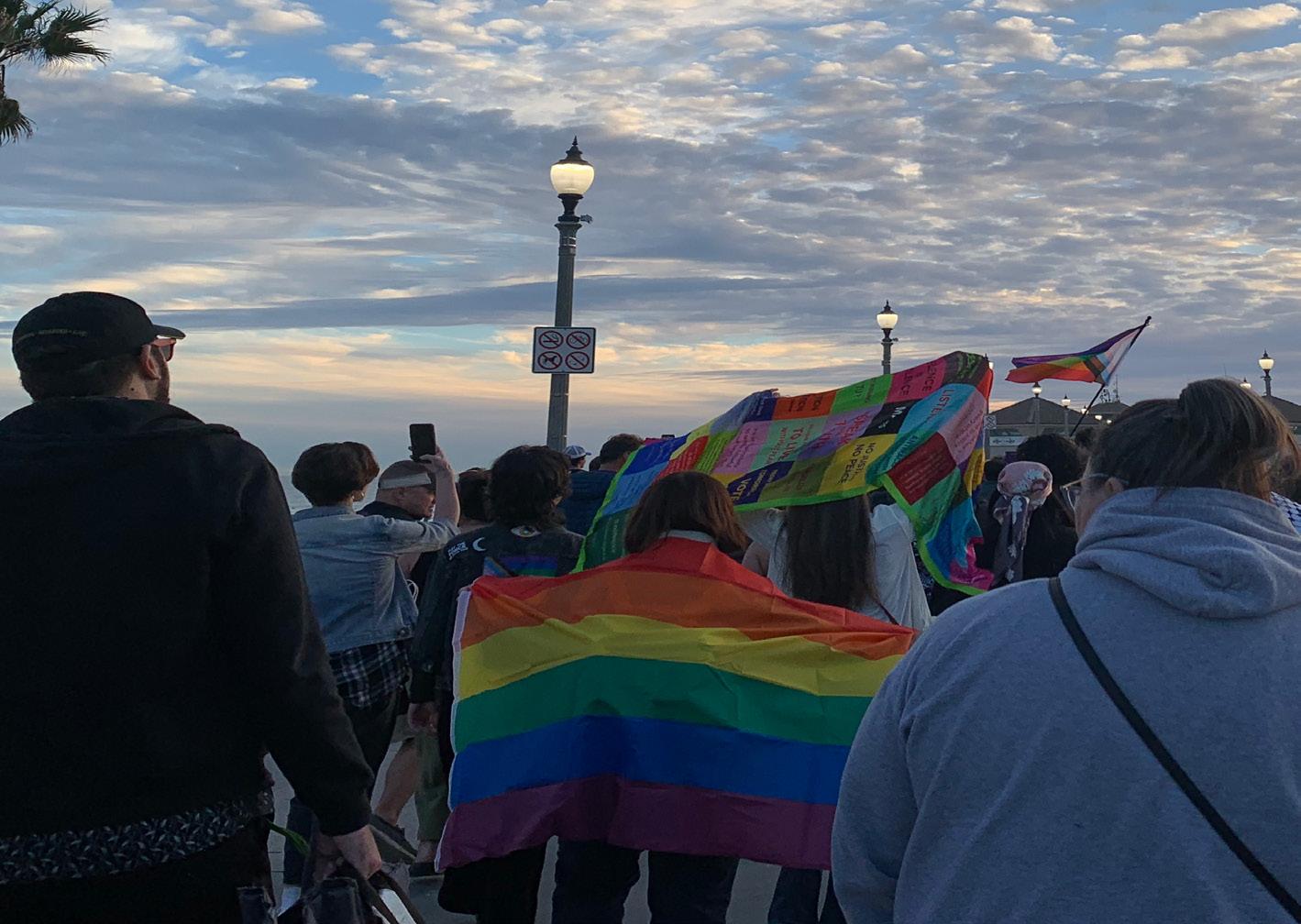
an LGBTQ center here in Orange County, there are a handful of queer establishments. Unfortunately, a lot of queer establishments are bars, and the majority of our student population isn’t of drinking age.”
Meschuk also feels that the lack of queer organization is probably another reason for a lack of knowledge about local politics on college campuses in Orange County.
“There is a problem with the lack of organizations that are showing up to meetings to resist legislation [and] stage protests,” said Meschuk. “Because [queer activists in Orange County] don’t have far reaching connections, we’re not really sure how to execute something on a large scale.”
Sanchez speaks from their experience as a queer activist who has been in Orange County for nearly a decade.
I’ve been…organizing [in Orange County] for years for years. I’m definitely a queer activist with those groups. They’re not sustainable, though,” said San

Huntington Beach residents march at the city’s pier after the death of teenager Nex Benedict.
Photo by Sarah Hartchez. “They always fall apart.”
Sanchez goes on to say that they feel as though here is work that people interested in getting into queer activism can do whether they are an ally or part of the LGBTQ community.
“Go take a class [on queer studies]. Get educated on the rich history, the academics behind it, the research. Then they can go in and be really awesome as an advocate,” says Sanchez. “We all got to do the work.”
According to Meschuk there is still work to be done to make students more aware of what’s going on locally. Still, Lien, now a senior, feels as though finding an immediate niche on campus is what got them to the end of their fourth year at Chapman.
“I feel better now that I joined different clubs and found different communities,” said Lien. “I have had professors who have advocated for me…and those professors really make a difference.”
When senior Caroline Shinner first came to Chapman University, her expectations of a college community were massively let down. Living in the middle of a global pandemic, she felt stuck in her dorm with her two roommates.
Until she had an idea to revive Chapman’s social scene, one vintage find at a time.
“[Chapman Flea and Thrift Club] are students from different walks of life coming together over one common hobby,” Chapman Flea and Thrift co-president Shinner said.
As the younger generations navigate through a tumultuous era marked by pandemics, social injustice, and global conflicts, there’s a yearning to look back at simpler times. And the collective nostalgia for low-waisted jeans, CDs, and mini handbags has turned into daily micro trends with the help of social media. College students can be seen wearing big baggy pants and mini skirts from the 90s, as styles from decades ago seem to make their way into every aspect of college life. And it couldn’t be more evi-
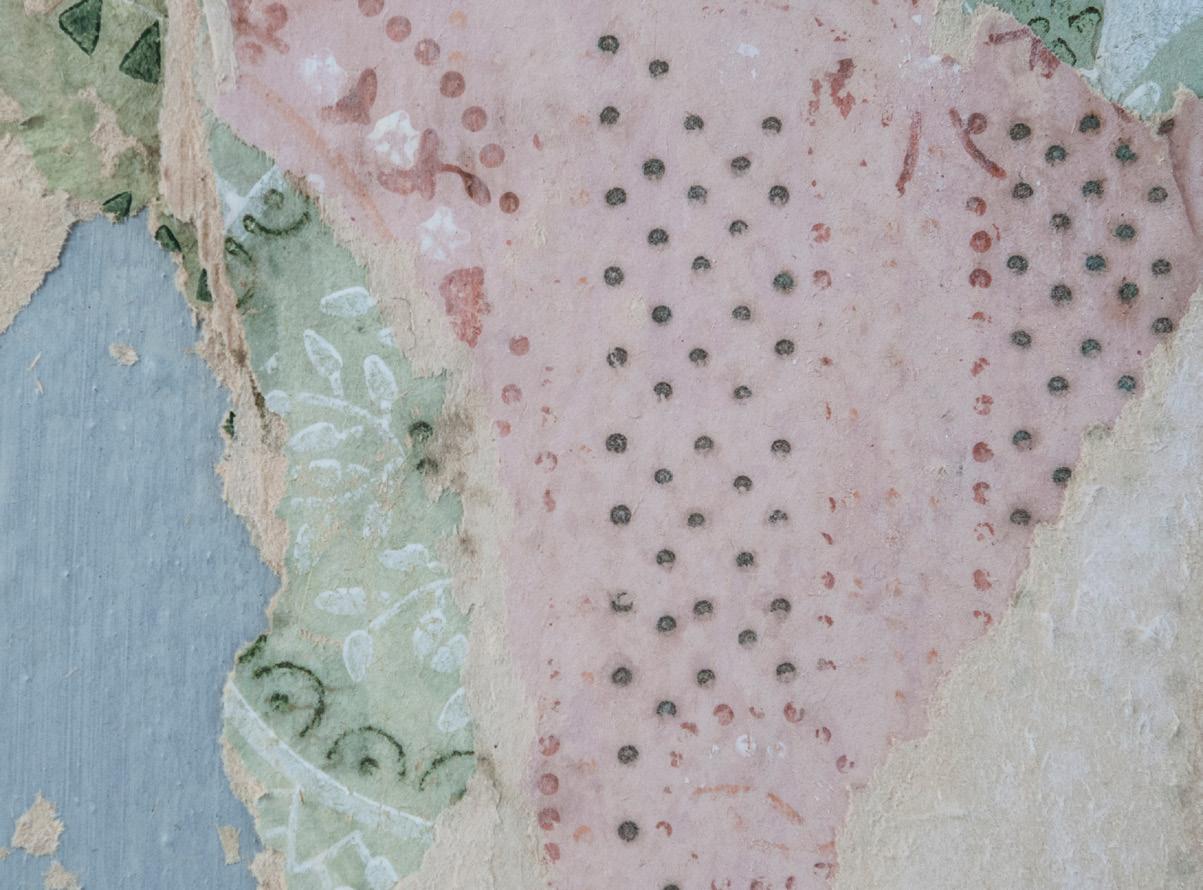
“When you’re seeing these styles every day, you start asking yourself, ‘Am I behind? Am I not dressing well enough?”
- Junior Shandon Obergon
dent than at Chapman’s campus.

“When you see a fashion trend on TikTok, there’s almost a 100% guarantee the next day you’ll see someone wearing it,” political science major Shandon Obergon said.
As fashion eras and music crazes from the
Consignment Store in the Circle. Photo by Nicole Kavros By Sukhman Sahota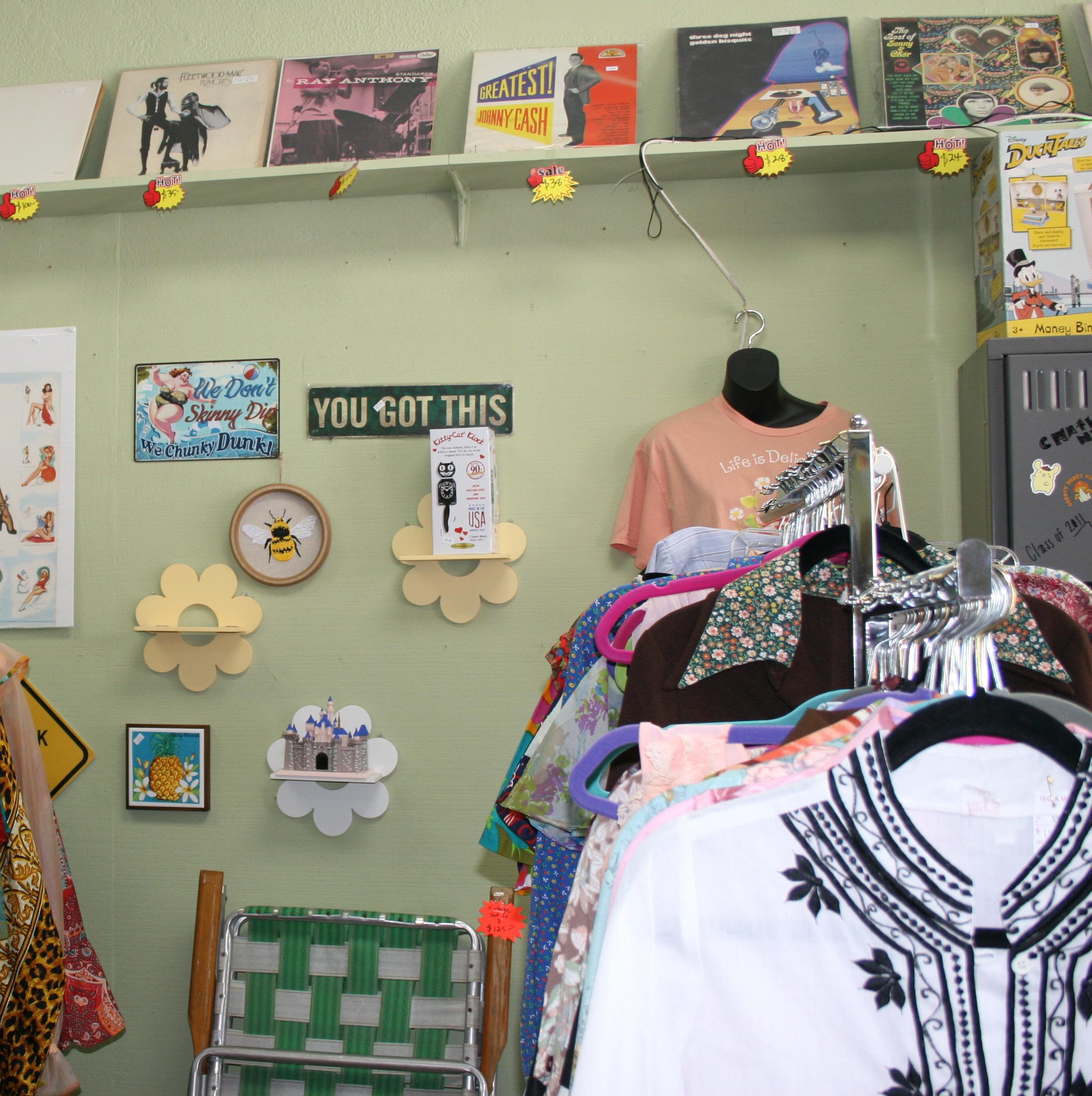
past rule over today’s culture, their accessibility can seem limited to some students.
Trends stay popular for a few weeks before the next big thing takes over, and participating in them can become a financial burden.
“We go to school with people of a higher so-
cial, economic status, so they have access to the quickness of these trends,” Obergon said. “They are on top of ‘what’s new and cool’ because they can afford it.”
For Obergon, it was easy to ignore the changes in fashion until he came to Chapman.
“When you’re seeing these styles every day, you start asking yourself, ‘Am I behind? Am I not dressing well enough? Am I not trendy?’” he said.
However, revitalizing trends are not new; they are pretty common. The only difference is the speed at which fashion trends stay popular.
“It’s not crazy that we’re having a fashion revival,” junior creative writing major Moria Wu said. “But what’s interesting is that the timespan between trends is getting shorter and shorter.”
Chapman Thrift and Flea offers a solution for students like Obergon when purchasing clothes. They host a flea market monthly with mostly Chapman student vendors selling their old clothes.
“We don’t make our vendors pay a fee to sell or charge tickets to let students shop around,” senior Chapman Flea and Thrift co-president CJ Dinowitz said. “It’s purely for the students by the students.”
Shinner and her roommates’ attempt to socialize with her peers during COVID-19 has become one of the biggest clubs at Chapman, founded with a center of fashion sustainability.
“You’re passing it [old clothes] down; it gets to live on and not go to a landfill. These clothes hold memories and value, and it’s a beautiful thing to share,” Shinner said.
Even though Chapman Flea is for college students, the vendors aren’t immune from the temptation of upselling — persuading a customer to buy something higher than it should be.
“I’ve gotten some stuff from there and definitely paid way too much for it,” Wu said.
Finding a balance between being on-trend and still having your style can take time for some students. But Chapman alum and Chapman Thrift vendor Adi Takei uses her individuality to dictate whether she’ll participate in a trend.
“If I see something trending, and I genuinely think it’s cute, I’ll think, ‘Yeah, I want to get it,’” Takei said. “It has to appeal to me.”

Wu uses a similar method to decide whether to incorporate a trend into her wardrobe.
“There’s nothing wrong with picking up on trends and seeing which ones you like, but like it’s more about genuinely thinking about it: ‘Does this fit into like the things that I already have in my wardrobe?’ and ‘I’m I gonna wear it in like three
Junior Will Swan selling his clothes at Chapman Flea and Thrift’s May event. Photo by Brian Guevara“Just by participating in the second-hand nature of clothing swaps is already a step above going to shop at Zara or Princess Polly [fast fashion companies].”
months,’” Wu said.
Some students try not to rely on ‘what’s new’ in the fashion world and find inspiration elsewhere, like walking on campus.
“I’ll see a person and really like how a certain article of clothing looks on them or how they’re wearing it, and then I’ll go out and try to find something like that,” Dinowitz said.
The Chapman Flea presidents built the club to spread knowledge about fast fashion — rapidly produced clothes with cheap fabrics and labor of the latest trends.
“Just by participating in the second-hand nature of clothing swaps is already a step above going to shop at Zara or Princess Polly [fast fashion companies],” Shinner said.
Creative and Cultural Industries Professor Lisa Maracine has spent her professional career pushing sustainability to the forefront of fashion. And for her, a college campus is the exact starting point.
“Many of the fashion-based social enterprises were started by college students seeking social justice at the intersection of the fashion, business, and nonprofit industries,” Maracine said.
While a small percentage of students end up working towards solving social justice, a majority of them start to take steps towards ethical shopping.
Starting with thrift stores.
“Although seemingly small [thrifting] helps with the overall cycle of fashion and can add up in the long term by unsubscribing from the cycles of fast fashion,” she said.
And Chapman’s surrounding area is perfect for students to begin thrifting.
“Since Orange has so many vintage and antique, it’s walkable for students to participate in second-hand shopping,” Obergon said. “I love Deelux or the Antique Mall in the Circle.”

Junior Moria Wu shares their thoughs on Chapman’s vintage and thrift culture. Photo courtresy of Wu

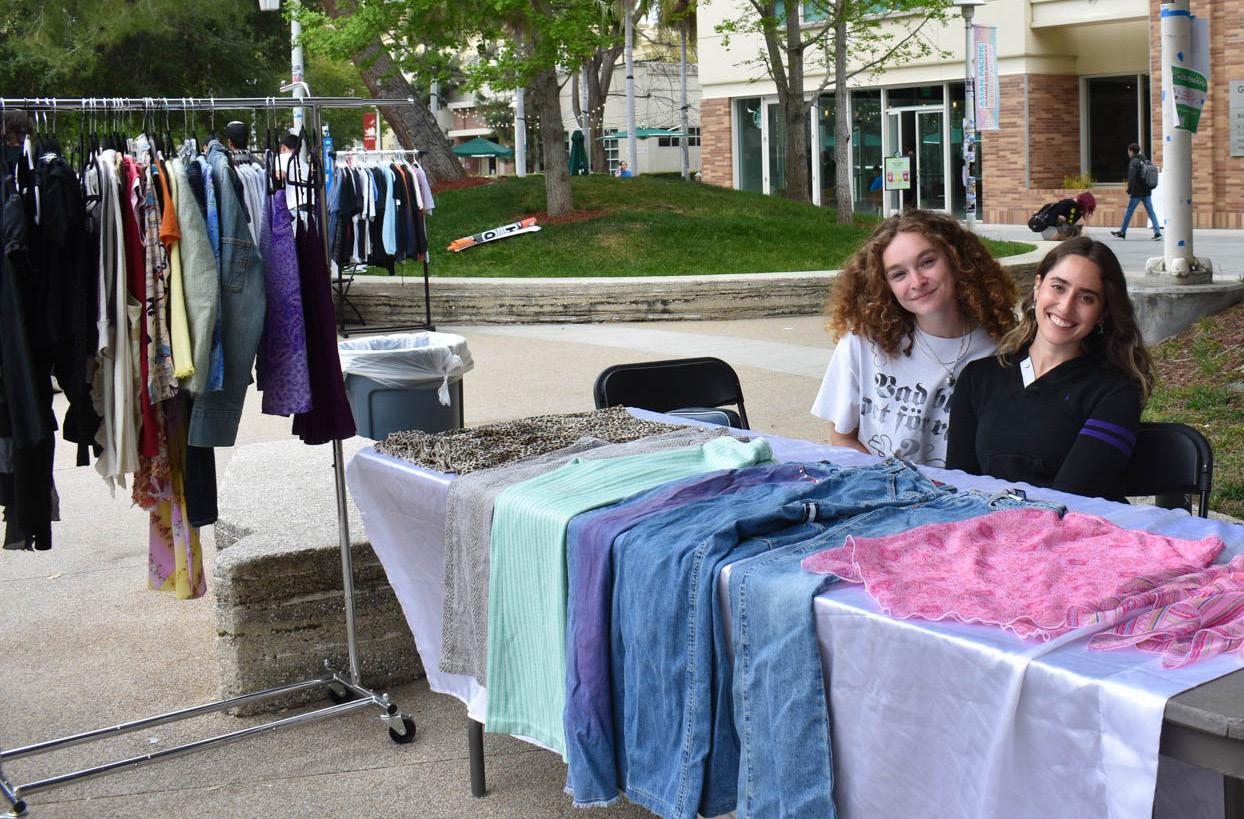
present clothes from second-hand stores.
“When larger companies take hold of these trends, they often sell the idea of a trend and not the actual physical embodiment of it,” graphic design major Easton Clark said.
As prices become out of reach at vintage or thrift stores, instead of shopping fast fashion, Maracine encourages students to champion companies with sustainability goals.
However, as thrifting becomes more pop ular for students, the increased demand drives up the costs at many of these stores. Wu has been thrifting since high school and has first-hand seen the price increase.
“Thrifting has become a privilege thing in some ways,” Wu said.
Wu isn’t the only one who has noticed this cost change.
“It has gotten to a point where it’s too expensive for people who go to thrift stores, not for trendy fashion or good finds to afford the clothes,” business major and avid thrifter Emily Paris said.
It forces people to settle for cheap fast fashion companies attempting to recreate
“Thrifting has become a privilege thing in some ways.”
- Junior Moria Wu
“Students can create change to shopping small or slow fashion by bringing awareness to those who are seeking to impact the industry on a small scale,” Maracine said.
Many students have found their interest in past fashion as a means of conveying themselves visually. Making it into a new hobby they can have forever.
“I like to be presentable and knowledgeable about what I wear because it’s an extension of you. It’s one of the only real things you can express yourself with and without verbally talking to somebody,” Clark said.
Clark’s interest in past trends goes beyond fashion.
“I have an interest in things vintage if you look at my design work, but it’s all old packaging and things that I’ve come to appreciate,” Clark said.
Vintage style has seeped its way into every aspect of Clark, allowing him to give
Co-Presidents of Chapman Flea and Thrift CJ Dinowitz (right) and Caroline Shinner at their last flea market. Photo by Brian Guevarahis clothes, work, and life more value and care.
Dinowitz and Shinner can both admit the pressure Chapman students may feel to conform to popular trends. A problem they hope to solve with their flea markets.
“On a college campus, everyone is trying to fit in and stand out in a certain way,” Dinowitz said. “But when you’re buying clothes from your friends or other students, it gives you a chance to garner that
sense of individuality that you couldn’t get from a fast fashion company.”
Trends come and go, but Obergon has found confidence in wearing whatever he wants rather than focusing on fashion trends.
And he hopes more students follow suit.
“In my opinion, sticking out like a sore thumb is the best way to go, especially at Chapman,” Obergon said.
“Students can create change to shopping small or slow fashion by bringing awareness to those who are seeking to impact the industry on a small scale.”
- Professor Lisa Maracine

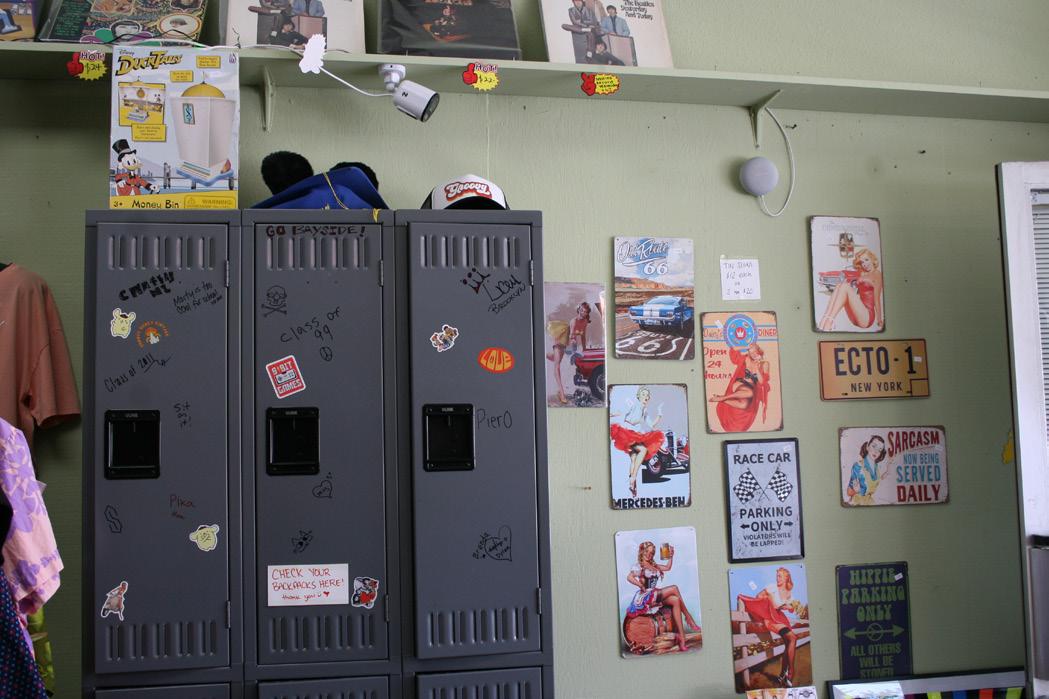



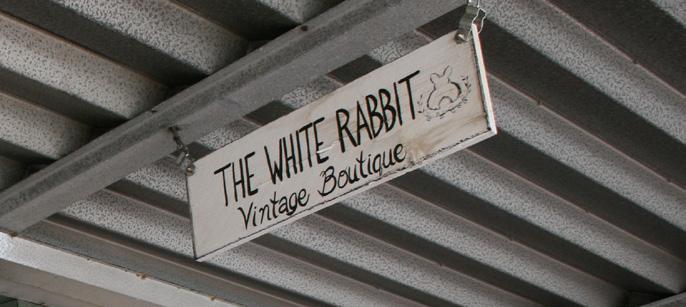

 Collection of photos of vintage store in the Circle and Chapman Flea Photos by Nicole Kavros and Brian Guevara
Collection of photos of vintage store in the Circle and Chapman Flea Photos by Nicole Kavros and Brian Guevara
Going into freshman year, communications major Etta Lauchland was more than excited to be part of Chapman’s school spirit. From clubs, to activities, to events, she was signed up for everything.
Now a senior, Lauchland groans at the idea of adding anything to her plate.
She’s been struck with a sickness too many seniors catch: Senioritis.
“I almost punched a man trying to get me to go to a career event,” said Lauchland. “I just want to head home after class.”
This sentiment is shared amongst many students who were once the wide eyed freshmen, excited to be part of Chapman. Now older, students don’t feel that same motivation to get out there and be involved. Whether it’s other time commitments, class loads too much, or the “senioritis” feeling, some students are tired of the extroverted life.
Jerry Price, the Dean of Students at Chapman, said he’s seen the senioritis bug spreading, but he sees it in a different manner.
“Some students do get senioritis where they kind of lose motivation all the way around,” said Price. “But mostly what I noticed is that their priorities change and their motivations are applied in kind of new directions.”
Lauchland said she loved her clubs and sorority meetings in the beginning, but after a few years, she found other commitments and dwindled out. This also meant that she wasn’t on campus as much as she once was.

 By Marjorie
By Marjorie
 Stremmler
Stremmler



“I think throughout the year I’ve spent much less time on campus, whereas when I did clubs and sorority, I was on campus all the time I was tabling and doing fundraisers,” said Lauchland.
Carter Hogan, a senior animation major, shared the same sentiment about being too busy for clubs and events, but since the end is soon, they want to make the most of Chapman while they can.
“I am busy now with things like my thesis, but I want to take advantage of what the campus has to offer,” said Hogan.
Hogan said there’s only one thing holding them back from doing everything they want: senioritis.
Senioritis is the idea that when students can see the end goal is approaching, they start to lose motivation to do just about anything. And Hogan said they’ve started slacking.
Lauchland backs up this sentiment, saying, “I think I’ve had senioritis since senior year started.”
“You would have to pay me to go to my classes now, I can’t go on my own free will,” said Lauchland.
With the impending stress of graduation and finishing those last classes, how can seniors find time to do events and other fun things Chapman offers?
Illustration of a senior totally not into what’s going on around campus. Photo courtesty of Aixian Wiriadinata
Kiana Kalahele, a senior English major, has cracked the code on finding time to get to all the events and clubs she wants, but she said it comes at a price.
“I’m currently the president of the three clubs,” said Kalehele. “It hasn’t died down since I’ve been a senior.”
Ever since high school, Kalahele said she keeps up with her clubs because she’s the type to “stick with it until the end.” She also said that since she’s paying to be at Chapman, she wants to get her money’s worth by putting herself out there.

But, Kalahele does say she is feeling the senioritis bug, but more with classes and less with clubs.
“I don’t wanna do anything or I’ve been procrastinating. But for club meetings and stuff I’m still very active. It’s something that I really enjoy doing” said Kalahele.
Losing motivation is not just a senior issue. Chloe Lehmann, a junior business administration major, doesn’t find herself on campus as much as she once was.
“I will only go to an event or something if I’m on campus, if even,” said Lehmann.
Jerry Price said while the administration can be a motivator to students, it also takes the willpower for themselves.
“I think there’s a fine line between being sympathetic and supportive, but also not somehow sending a signal that obligations don’t matter anymore. They still do and they’re always going to,” said Price. “If you have obligations you’re responsible for seeing them through.”
Even with Chapman pushing for students to get out there in clubs and events, some have never had the desire to show their school spirit.
Sydney Scott, a senior English major, said she was much more into what high school had to offer her, but now in college, she’d much rather go to class and head straight home.
Kiana Kalahele taking a selfie in her new gown. Photo by Kalahele“I was involved in everything in high school, from class in the morning to soccer games at night,” said Scott. “Now I have ‘college-itis.”
Scott said she’s tried going to the club fairs, but didn’t find anything of interest. She’d rather make her own fun outside of Chapman.
“I like taking day trips or going to LA with friends, not being on campus,” said Scott.
Even with the loss of interest, Etta Lauchland, and the other seniors, still encourage students to get involved and try everything when they still have the chance.
“Sign up for as much as you can,” said Lauchland. “If you don’t like it you can always quit or drop it, but you’ll definitely find something that you’ll be really into and want to stay in for all of college.”
Etta Lauchland posing for her grad pictures. Photo courtesy of Lauchland

Even Jerry Price leaves a message for the students who might have any regrets for not branching out.
“Investing a lot of energy backwards is not a great investment,” said Price. “It’s good to reflect and learn, but regret and shame are only valuable in small doses. Putting your energy into things you can actually change and do something about is the best advice I could give.”
Lisa

Junior Lisa Wong walks into the Henley Hall basement every Wednesday night, puts on her headphones, and starts talking into a mic with her co-host Chloe Wong.
She doesn’t know how many people are listening, but it doesn’t matter.
She loves her Chapman Radio show, “State of Mind,” and 60+ episodes, it’s a highlight of her college career.
“Is there ever going to be another time where I get to capture a weekly conversation with my friend for the whole world to hear?” she said.
Listener numbers might not be high, but the Chapman Radio brand is growing. It has survived over the decades to be Chapman’s second oldest program. It now even has its own credit class. And it’s even getting national attention. Chapman Radio in recent years cracked into the Top Ten of the best college radio stations according to the Princeton Review.
Chapman Radio Goes from Henley
By Allie LeichterIts 70+ shows and sports broadcasts have been gaining relevance in recent semesters. Even though it’s not getting Netflix level
Juniors and Chloe Wong (from left) doing a broadcast in the piazza. Photo courtesy of Lisa Wong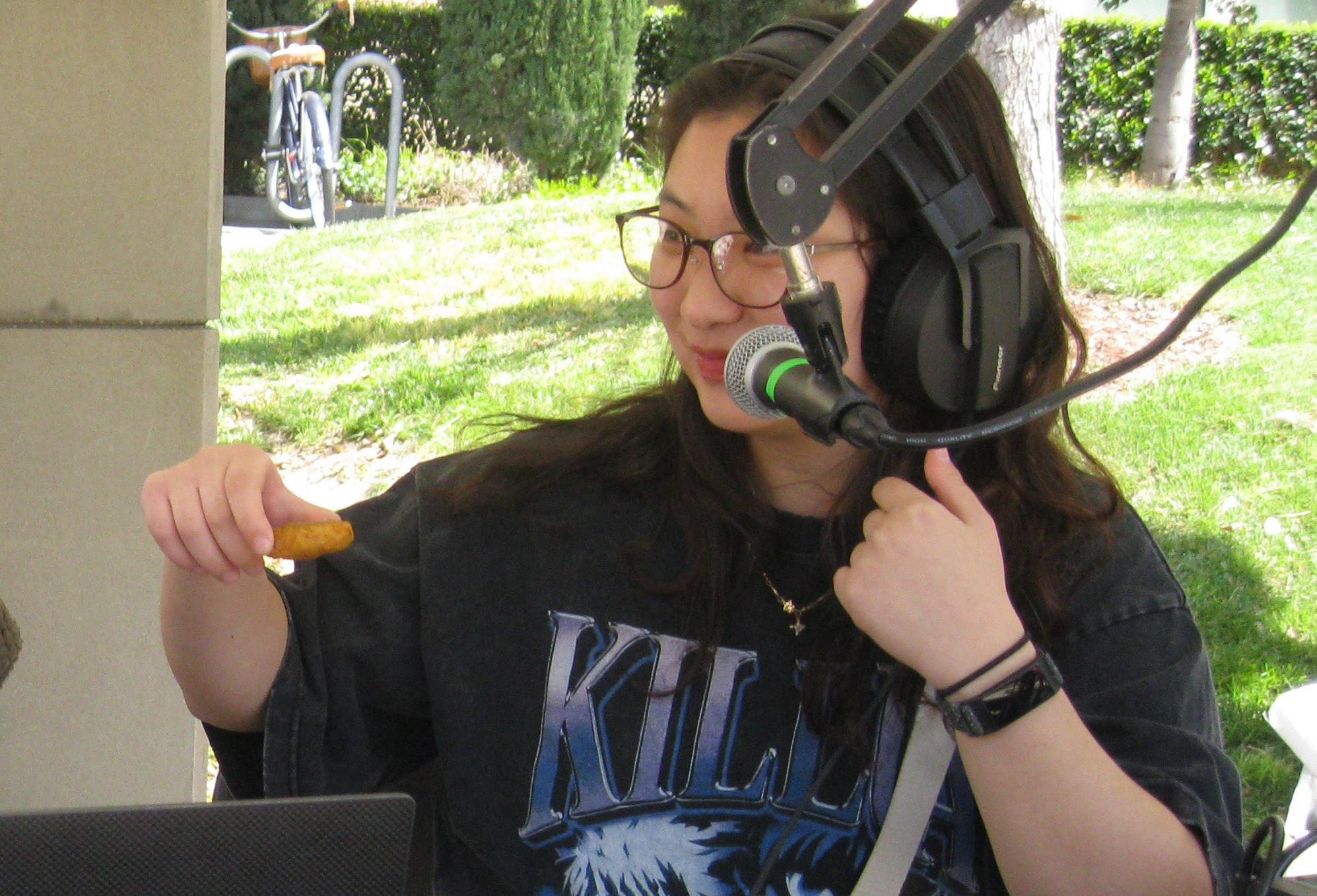
Henley Basement to Headlines
Leichter and Brian Guevara numbers — just over 100 listeners for each segment would be at its peak, its followers have proven to be dedicated listeners.
“I love listening to Chapman Radio. I think it’s another way to bring students together and support friends” said junior film production major Rithika Vighne.
But how have the DJs and engineers done this? How have they found footing in the Chapman community,
and where could they do better?
It’s gotten popular recently due to its Covid-19 era overhaul, which allowed the station to change its approach.
There are three streams accessible to students on the Chapman Radio website and app: sports, music-only, and student talk shows. Each with multiple DJs.
For those who struggle to find the station, all streams can be accessed by downloading the Chapman University Radio app on the Apple App Store or the Google Play Store.

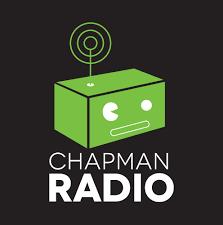
“We want to be [formatted] more like a Netflix, a Prime, or a Hulu where you can pick and choose what you want to tune into. We want to be the future of radio.”
-Professor
Travis Bartosh


The 24-hour live stream consists of weekly shows with music in between. They also have their own events ranging from live broadcasts on campus with students to open mic nights.
As popular as Chapman Radio has been compared to other college stations, though, there are many students — most students —- who don’t listen at all.
Senior vocal performance major Evan Raymond finds it hard to engage with the station for multiple reasons.


“I’m not too in-touch with the campus culture and don’t care much about audio-only media,” said Raymond. “I’m surrounded by Chapman whenever I’m on campus and don’t want to hear more Chapman when I go home.”
Another thing Chapman Radio is susceptible to is the high turnover rate. Students who take initiative graduate and younger students who aren’t as attached to the program come in. The culture can always change at the station and it has ended with struggle.
While listenership can always be improved, the involvement in the station itself is at a high. The reason why stems from how easy it is to get involved.
Chapman Radio has its own class, COM 108, where students learn and put into practice engineering and programming skills. They even have their own club. They can run their own show, or help produce.


Who hasn’t imagined themself having a radio show? With this program, students can actually become an on-air personality, with listeners and a studio.
Travis Bartosh on air for Chapman Radio. Photo courtesy of Issuu
“On a personal level, it brought me closer to the people who listen to my
show. We have group chats where we chat about the show and they even send me messages about what I am saying while we are on the air.”

- Junior Chloe Wong, “State of Mind cohost
Not that the numbers don’t make them wince at times. Many of the shows have 80-plus listeners at a time. But for a few, they can count listeners on one hand.


But many do listen for the music, which plays between shows, and is piped in to the Student Union.
“I really enjoy their music,” said junior film production major Gwendolyn Allison. “When they play Taylor Swift it makes me dance a little bit.”
Not all students feel this way, however. Senior JP Olalia, in fact, feels the opposite.
“It’s cool. I don’t know, I spend a lot of time in AF and I don’t really care about the music they’re playing,” he said. “I just tune it out.”
The popularity and on-campus success of Chapman Radio can be questioned, but one thing is certain: It helps students

Jerry Price posing with the Chapman Radio mascot. Photo courtesy of Chapman Radio
succeed in getting broadcasting jobs.
“What I tell the new DJs is that you’re only ever talking to one person,” said Bartosh. “The point of college radio isn’t listenership, it’s about training the DJs to be the best they possibly can.”
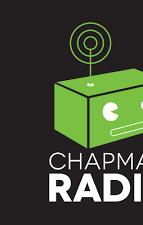



Chapman Radio Logo. Graphic courtesy of Chapman Radio

One example, 2011 graduate Tyler McCusker, who was the station’s student manager, went on to have a successful radio show in Palm Springs, then later owned his own radio station in Laguna Beach.


Dodgers last year, often gives thanks for his position as sports director, producer and host on Chapman Radio.
Maybe, just maybe, a current




For an even more successful example, Chapman 2010 graduate Stephen Nelson now is one of those currently filling the historic shoes of Vin Scully, a legendary baseball commentator for the Los Angeles Dodgers, who died two years ago.
Nelson, the only Asian American play-by-play announcer in major league baseball when he joined the
Chapman Radio student will join him in success in the future.

Maybe, that student is Lisa Wong.
Her show, a combination of music and music talk, has won multiple “Chapman Radio” awards, and has over 100 followers on Instagram. This might just be the thing she ends up crediting in 10 years for her successes. As a student that wants to go
 Photo of former Chapman Radio sports director, producer and host, and current Dodgers play-by-play announcer Stephen Nelson. Photo courtesy of TrueBlueLA
Photo of former Chapman Radio sports director, producer and host, and current Dodgers play-by-play announcer Stephen Nelson. Photo courtesy of TrueBlueLA
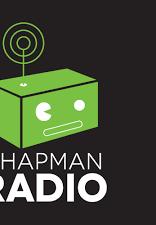
into broadcasting, she believes Chapman Radio has prepared her well for that world.
“Being [a DJ] has helped me develop skills that I know will be beneficial to wherever I end up in the sports or news world.”
-Junior Lisa Wong, “State-of-Mind” co-host






 Evan Fenley and Jordan Beal in the Chapman Radio booth hosting their weekly show, “Life With Jevan.” Photo by Brian Guevara
Evan Fenley and Jordan Beal in the Chapman Radio booth hosting their weekly show, “Life With Jevan.” Photo by Brian Guevara
Many students say an accelerated master’s is worth the challenge
 By Holland Hatch
The work for 4+1 students doesn’t stop after undergraduate graduation.
Illustration by Holland Hatch
By Holland Hatch
The work for 4+1 students doesn’t stop after undergraduate graduation.
Illustration by Holland Hatch
Emi Thomas, English journalism major, will be graduating in a few weeks. But while her peers are moving on to careers, she’s still stuck at Chapman.
Not that she’s complaining. She’s going to graduate again next year. This time with a master’s degree.
It’s called 4+1. Students can take master’s classes as an undergraduate to give them a head start. That way they can get a master’s degree in just one year instead of the usual two.
For Thomas, that means working overtime right now to keep up – and being left behind by her friends. Which can be a little awkward.
“So many people are ready to take the next step in their lives, and I’m just here,” said Thomas.
Thomas is a part of the Integrated Bachelor’s/Master’s in English that allows her to take graduate level courses starting her senior year of undergraduate. This program is just one of 19 integrated programs that Chapman currently offers.
Students are able to apply for this growing 4+1 program anytime in their junior year. But for now, only a small number of Chapman’s nearly 8,000 student population is taking advantage of it due to the heavy schedule required.

But those who do say it’s worth it.
Erick Cunanan, for example, is currently in his last semester in Chapman’s accelerated health and strategic communication master’s. Cunanan graduated last spring with bachelor’s degrees in both psychology and strategic and corporate communication.
Cunanan described entering the graduate program last year as intimidating, requiring him to hurdle a tremendous mental barrier.
“[Grad school] is a beast,” said Cunanan. “It’s something that people cry over.”
But the familiarity of the Chapman culture and community has helped him thrive. Some not in the program still stay at Chapman for a master’s.
“[Grad school] is a beast.” - 4+1 student Erick CunananSenior Emi Thomas. Photo courtesy of Thomas

Emily Hayes, MBA class of 2026, missed the deadline for 4+1. But she still had her heart set on Chapman for her graduate degree.
“I have roots here from undergrad,” said Hayes. “So I was going to stay at Chapman or nothing.”
As Hayes finishes up her first year of graduate school, she admits that being left behind by the rest of her graduating class has been difficult.
“I kind of still feel like a kid,” said Hayes. “Stuck.”
But at the same time, this “extension of undergrad” according to Hayes, has been a positive experience overall. Hayes has been able to stay connected with her community at Chapman through her sorority and softball team with eligibility from the COVID-19 pandemic.
“I do feel more isolated,” said Cunanan. “I’m no longer a part of the Hawaii or Filipino club.”
Cunanan has remained the president of the Communications Honor Society, Lambda Pi Eta, for the past two years, which has helped him maintain involvement. But he attributed most of his connections to his 4+1 cohort of students.

Dean of Students Jerry Price described the 4+1 program as complex.
“On paper it looks so smart,” said Price. “But the experience of doing it is different.”
Thomas addressed the uncomfortable middle-man position she holds as both an undergraduate and graduate student this year.
“I get serious imposter syndrome every time I go into my graduate classes,” said Thomas.
Cunanan has also kept connections with his Chapman community, but admits he is rarely on campus anymore.
Cunanan also described his experience as a simultaneous undergraduate and graduate student as “very confusing.”
“I had to figure out how to balance my
Erick Cunanan celebrates his 2023 undergraduate graduation. Photo courtesy of Cunanan
Dean of Students Jerry Price reflects on the 4+1 student experience. Photo courtesy of OC Register
identity,” said Cunanan.
Dean Price emphasized the difficulties students face during this transition period.
“It gets tricky,” said Price. “When you stop being a senior and start being a graduate student is not a clearly defined line.”
This leaves students like Thomas and Cunanan with a lot of logistical questions beyond their emotional confusion.
“There are financial aid implications, registration implications, housing eligibility questions,” said Price. “We help to resolve some of those things.”
The rigor of preparing for and completing a master’s degree is not for everyone.
Lyn Sazon, junior communications major, discovered this early on in her time at Chapman.
Sazon started her Chapman career in the
accelerated pre-pharmacy program. Even more intensive than other accelerated graduate programs, pre-pharmacy is a two year undergraduate experience followed by three years of graduate school at Rinker campus.
“I was 17, getting ready to start graduate school at 19,” said Sazon. “I just wanted to enjoy my college life.”
Graduate level classes are a lot of stress, especially in conjunction with completing an undergraduate degree. The demanding
“I just wanted to enjoy my college life.”
- Junior Lyn Sazon
course load requires a sacrifice of the traditional relaxing senior year. Or in the case of accelerated pre-pharmacy, a sacrifice of a traditional undergraduate experience overall.
“I know a lot of seniors who are part-time because they don’t have anything left to do,” said Thomas. “I’m constantly doing homework all the time.”
But to her, the hard work now is worth it for one less year of school.
“All that time and effort is going towards something worthwhile,” said Thomas.


Many excited students flocked to tour the new Chapman Court apartments within the past month.
But for some, they left the tour knowing they’d never live there.
Sophomore Cami Martin was one of those who dropped out. Why? Inadequate parking.
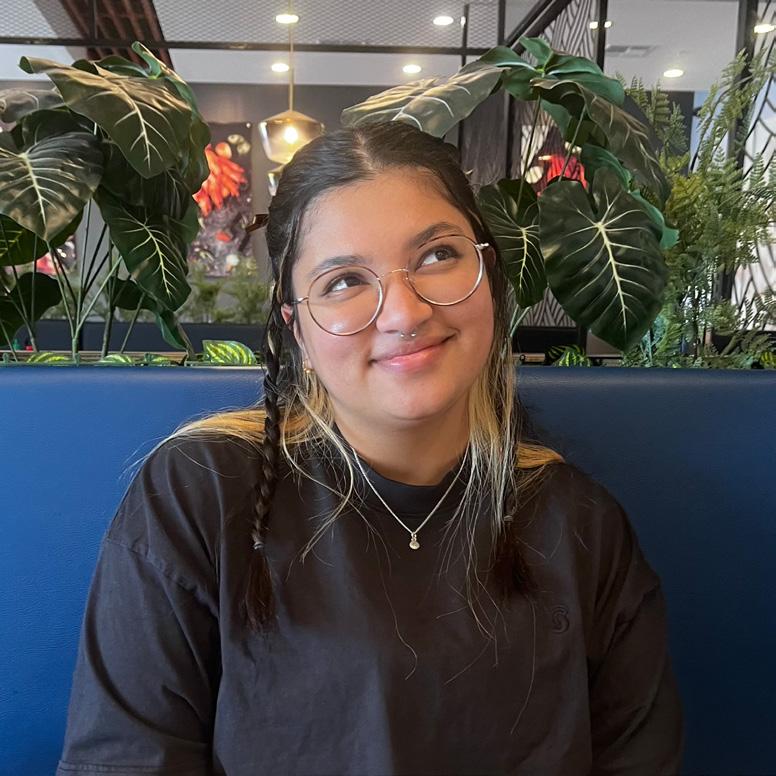
“I’m from out of state and if I weren’t able to get a parking spot at Court, I wouldn’t have anywhere else to put my car,” said Martin. “I’m pretty car dependent, so I need a parking space and being told there was a high chance I wouldn’t be given one, was an immediate no for me.”
A quick three miles from campus, Chapman Court is the latest addition to Chapman housing. With Chapman’s newly implemented three year housing requirement, Chapman Court serves as a solid housing option. Sophomores and above can live in Court, but the housing lottery is on a first come, first basis.
Offering larger rooms than other Chapman complexes, with up to date applianc-
“Being told I wouldn’t have a parking space, was an immediate no for me.”
- Sophomore Cami Martin
es, a two story gym, and no price difference between the alternative off-campus housing options. How could students resist?
However, some students left their tours over the parking. With 600 parking spaces available, despite 800 students planning to be housed there, they worried it wasn’t the right fit for them.
For those students who aren’t lucky enough to acquire a parking spot in the garage, the alternative is parking at Panther Village, which is a 15 minute walk away.
Chapman Court’s housing team informed students that, “Parking is assigned by unit and at this time requests for additional spaces are not being accepted.” Therefore, it’s safe to assume that Panther Village’s lot will be packed with Chapman Court’s overflow parking, which causes anxiety amongst potential residents, like junior Katy Wathen.
“What if you bought groceries but are forced to park in the overflow lot and have to haul them on the shuttle, or if you come back super late and the shuttle service isn’t operating anymore?” said Wathen. “So I just decided to stay safe rather than sorry and live at Chapman Grand again next year.”
Cami Martin. Photo Courtesy of MartinTracey Cervantes, representing Chapman’s Parking and Transportation program, assured students that, “5 shuttles have been purchased to expand services to accommodate students living at Chapman Court.”
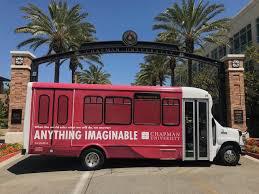
However, the shuttle only runs Monday-Friday 7:30 a.m. to 11:55 p.m. and weekends 9 a.m. to 8 p.m. Students who may be traveling outside of those times have expressed safety concerns making the 15 minute walk, from Panther Village, alone at night.
“Having to park and walk from Panther Village was an absolute deal breaker for Chapman Court, especially since I usually have class or rehearsals until 10 p.m.” said junior Rose Lindblom. “Then once I’m at Panther Village, I’d either have to wait for a shuttle to Court or walk home, and I would not feel safe making that walk at all, let alone at night,” continued Lindblom.
Chapman Dean of Students Jerry Price defends its housing selection.
“Court was selected because it was avail-
“Having to park and walk from Panther Village was an absolute deal breaker for Chapman Court
- Junior Rose Lindblom
able. We were in the process of planning to build a new facility with about 1,100 beds where the current Panther Village is. It was going to be very expensive and take about four years,” said Price. “With Chapman Court, we could get the same amount of beds- immediately.”
Despite Court being a popular housing option, Dean Price does understand the anxiety students feel regarding the parking situation, “A lot of people don’t want to be the guinea pig with this, but it might end up working fine. We just have to wait and see.”
However, with so many students not living in Court, that frees up a lot of space for excited incoming residents. Many students seem to be pleased with the modern aspects of the complex.
“Chapman Court was appealing to me because it’s the ‘new’ thing. It has a resort type of vibe with the cabanas and pool. My room specifically has a gigantic kitchen which is going to be so nice to host weekly dinners with friends,” said freshman Ruby Beckerman.
Sophomore Eliza Gibbs seemed to agree with Beckerman, “I also chose Chapman Court because of the newer features.”
With Chapman Grand and The K being the two most popular housing options, students find the newness of Court very refreshing.
Photo Courtesy of Chapman Website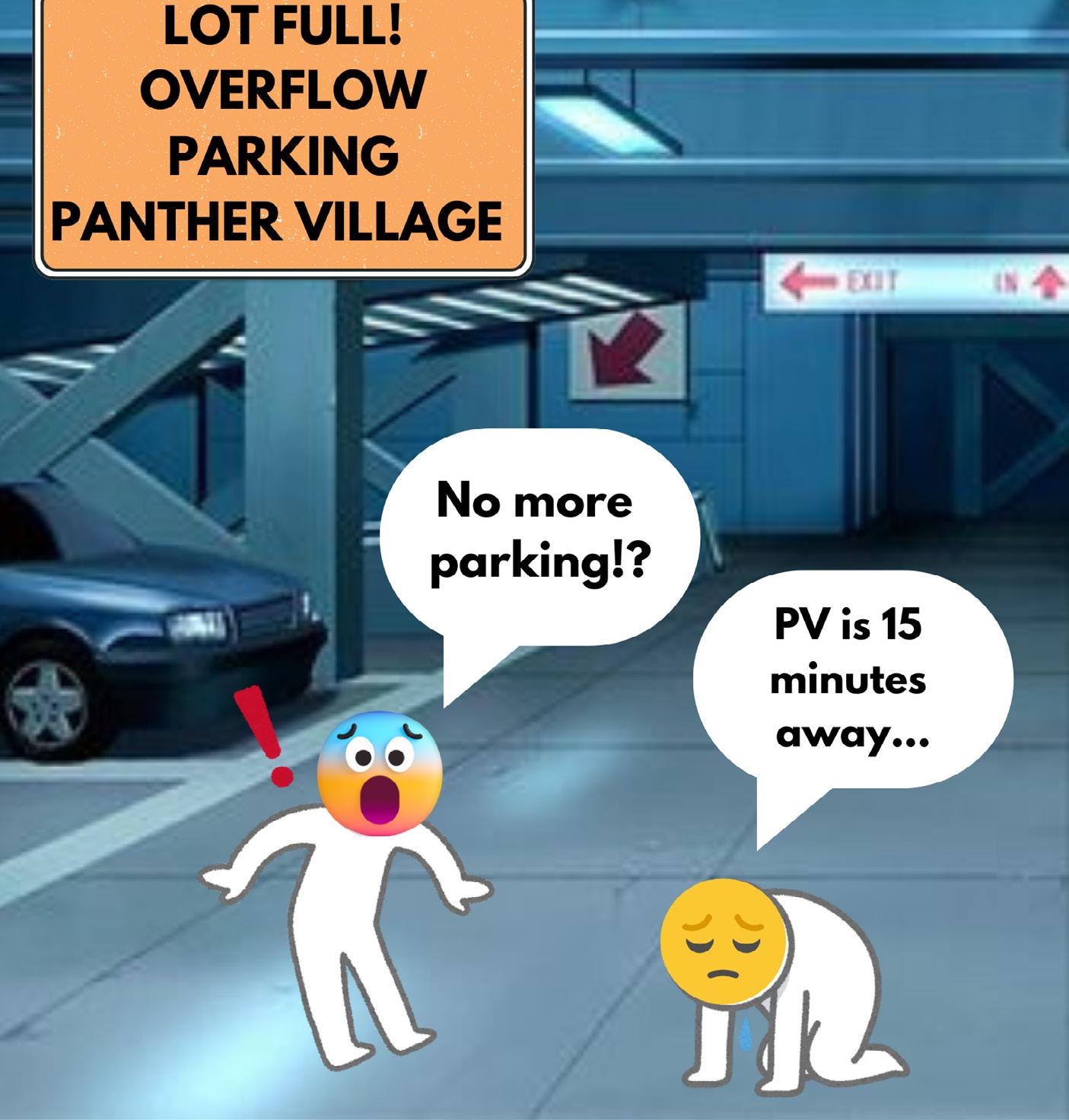
“I decided to live in Chapman Court because I knew that I wanted to live off campus, and the building is brand new which was appealing to me. I also really liked the amenities that came with living in Court,” said freshman Dylan Magic.
Despite Magic not having a car, she does feel concern for her roommates, who will have to navigate that situation, “I am currently unsure how many of my roommates will have cars next semester, however, if all of us bring cars, I will be more concerned with what to do with the extra car.”
It seems for those who aren’t concerned about parking, Chapman Court will be a great fit.
The building officially opens for move-in in August 2024.

by Sophie Wehrlie
Illustration by Sophie Wehrlie Photo
 Graphic by Brian Guevara
Graphic by Brian Guevara
Chloe Smigla was stressed in the fall of 2021. Stressed about internships.
She needed an internship for her Strategic and Corporate Communications major, but those were hard to come by. The only ones she could find in her field were summer internships.

And she would’ve had to pay for it.
“It just felt so backwards to have to pay to work,” said Smigla. “That just sounds wrong.”
Internships have been getting more competitive every year. More students are applying than ever, and yet the actual number of internship positions are declining, according to Forbes. But just how difficult is it to get a desirable internship in a relevant field? And what is Chapman doing to address difficulties students might have getting one?
Student Internship Lead Henry Crowe explains that getting an internship recently has been rough for students, and for one large reason:
The job postings aren’t real.
“Companies are posting internship positions they’re not actually hiring for,” said Crowe. “They look internally but create
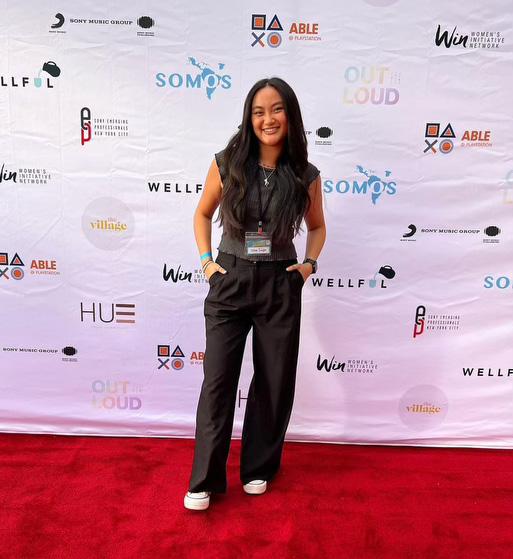
postings because they’re ‘required’ to.”
According to Crowe, Chapman’s solution to this is Handshake.
Handshake, which is available to all Chapman students, is a platform that shows students internship and job postings that are looking for college students, particularly Chapman students. All postings are reviewed by the university and checked for legitimacy so students have the best possible chance at getting experience.
This has helped Chapman students find some success with internships, with an estimated 70% of students having at least one internship in their time at the university according to Chapman’s career education manager Janelle Farkas. That’s nearly double the national amount.
Smigla at an event hosted by the company she was interning for last year. Photo courtesy of SmiglaAmong those students is senior educational studies major Jordan Beal, who has benefited from Handshake. Thanks to the software, she got an internship at Make-A-Wish, something she considers to be a shining entry in her resume.
“I got my internship because of Handshake,” said Beal. “It made my resume so much stronger going into grad school.”
It hasn’t worked for everybody, though. In fact, junior Lyn Sazon believes it’s more about who you know than any Chapman service.
“Chapman didn’t help much with connecting me to opportunities,” said Sazon, who recently has worked for TMZ and Warner Records. “I had to hustle on my own and apply on every website and portal. I didn’t even have a mentor.”

Sazon at her internship in 2024. Photo courtesy of Sazon
Farkas agrees. To an extent.
“Networking is an important part of job searching because it allows someone to help vouch for you. That can help move your application along in the process, but rarely does it “guarantee” you the job,” she said.
She believes it’s about knowing people, but also that it’s in students’ control.
“It’s less about knowing the ‘right people’ already. It’s more about being willing [to] initiate conversations by introducing yourself and your merits to new people in your field.”
- Career Education Manager Janelle Farkas
This essentially means that every student has the power to make connections, and Chapman simply makes it easier for them.
While Chapman may not be of help to some students, multiple schools in the university take internship opportunities into their own hands, with department chairs directly reaching out to students with information.
That includes Crean College, which senior health sciences major Kate Sheafor has to thank for her internship.

Chapman’s Career and Professional Development Center helps students find internships. Photo courtesy of Chapman University
She found her job through an event organized by the college where speakers came and had information about internships.
“That was so helpful. I don’t know how I would’ve found an internship otherwise.”
- Senior Kate Sheafor
What if students can’t find an internship? Maybe their grades aren’t good enough. Maybe they need a paid job to deal with tuition.
Crowe has seen this before, and believes Chapman has a solution to that as well.
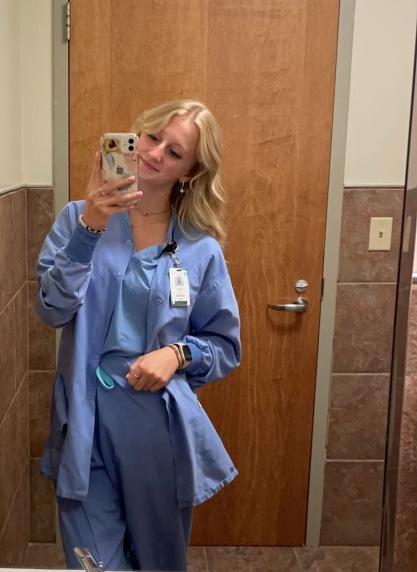
Sheafor at her internship last year. Photo courtesy of Sheafor
“We can help students find internships that don’t check GPA or experience. We can also help make their resume and application as optimized as possible to make up for any otherweaknesses.”
- Henry Crowe,
On top of this, Chapman gives students free access to Udemy courses through the Argyros College, allowing students to nurture their skills in ways that help their resume.
Some students believe internships aren’t very fair. They’re doing work for a company, but aren’t getting paid. In some instances, they’re actually paying money to do work for their employer, which makes no sense to some.
Sazon nearly fell victim to this possibility. Her freshman year, she got a summer internship but decided not to have it registered for credit, since she didn’t want to pay to work.
She risked not counting an internship in her field at Chapman, because of this policy.


Percentage of current students that have had at least one internship in college. Graphic by Brian Guevara
 By Alexandra Der Boghosian
Illustration by Alexandra Der Boghosian
By Alexandra Der Boghosian
Illustration by Alexandra Der Boghosian
Ever had a business or start up idea that actually had potential? But couldn’t do much about it because you are still in college.
That isn’t a problem for a growing number of Chapman students.
That’s in part because Chapman’s Leatherby Center for Entrepreneurship and Business Ethics not only has classes in the field, but its own mentorship program to help students get a head start.
One of those is Taylor Green, a junior who now has her own baking business and is getting dozens of orders each month. Her business, Taylor Baked, offers a variety of cakes and pastries and delivers in the Orange County and Los Angeles area. However, Green’s speciality is adding health conscious restrictions, such as gluten free and peanut free ingredients.
Chapman programs. From baking to jewelry to tech companies, Chapman student entrepreneurs are breaking barriers
“The resources at Chapman definitely helped me guide my business and allow me to further develop my business after graduation,” said Green. “It felt very validating for someone to see my vision and take the time to listen to me and say ‘okay, what can we do to help.’”

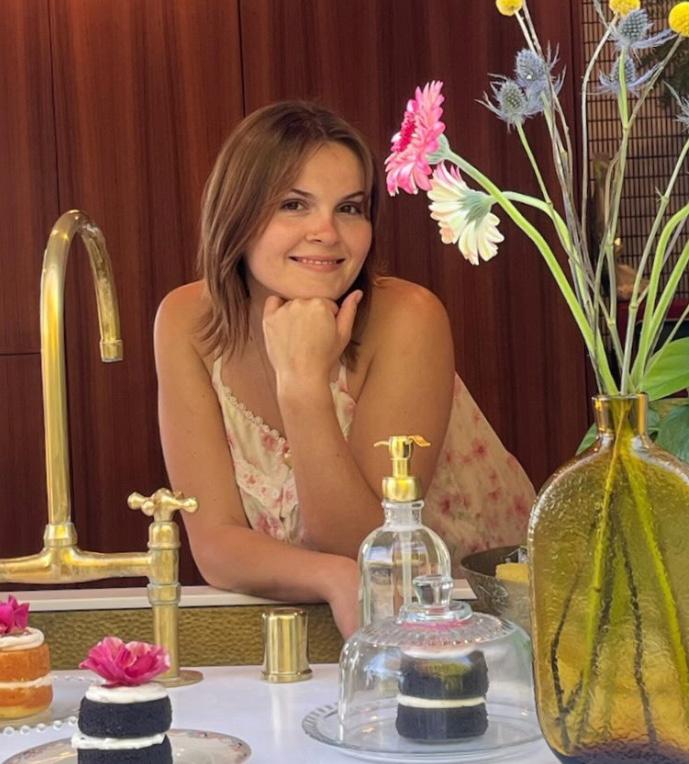
As the semester started in the fall, Green realized that running a business and going to class will take a lot of patience and time management.
“Our vision is for students to have an entrepreneurial mindset. Whether students have their own company, a start-up or go to work for a large corporation, you can still bring that mindset with you,” said Cynthia West, director of the Leatherby Center.
“Baking is my creative outlook, I may feel stressed at times but because baking is very therapeutic for me, I enjoy it,” Green said.
In this new world of social media and advanced technology, a new era for students is emerging in college campuses – studentpreneurs. Chapman student entrepreneurs have been working on creating their own startup empires with the help of different
The Center, which guides the students through their journey, has more than 80 different mentors from different entrepreneurial backgrounds and experience.
“From getting hands-on experience to networking, I’ve seen students grow and take their start-ups to the next level,” said West.
“The Leatherby Center has really helped me with my business and get the word out,
Taylor Green showcases her sweet treats. Photo courtesy of Taylor GreenBy starting from scratch and making it on her own, entrepreneur and senior Carissa Nelson began her jewelry business in middle school when she began creating handmade hair bows. During her freshman year, she created her very own jewelry business, Eye Candy by Iris. With now over 900 followers, Nelson has grown her business with a professional website and eclectic style of jewelry.
“It’s something that I’ve always had a passion for, I like creating things, I like having a platform to show that creativity and I love sharing that as well. I do everything,” Nelson said.
In Eye Candy by Ris, Nelson has taken the role of founder, owner, website designer and creative director. Taking jewelry and student-run businesses to the next level.
“In the beginning, starting was harder because I took a full load of classes. But at the end of my junior and senior year, I’ve been able to focus more on the business. If a student is serious about a business idea, I say go for it. But you need to be 100% and committed,” Nelson said.
Jewerly from Eye Candy By Ris
courtesy of Eye Candy By Ris website

neurship club organizes meetings by bringing in local businesses and entrepreneurs to discuss their business and their experiences.

“It’s very rare you get the chance to talk about your idea and get real life feedback from real life entrepreneurs,” said Aylo Corshen, a senior business administration student and the president of Chapman’s Entrepreneurship Club.
Students with business and entrepreneurial goals have the opportunity to visit the Leatherby Center and get their business to grow as a college student. The center works with the Entrepreneurship club to collaborate on events and workshops. Every Friday the entrepre-
Corshen has been involved in the entrepreneurship club for three years and competed in the 2022 Panther Cage Match, a competition where students can pitch startup ideas to a group of judges, ultimately networking and maybe getting the opportunity to take their idea to the next level.
“Just do it, it will be something you learn no matter what and students are lucky enough to be at a university that encourages people to try, rather than discouraging them to not having a ‘perfect’ idea,” Corshen said.
The Leatherby Center for Entrepreneurship and Business Ethics collaborates with the student club but also coordinates events for the community to strengthen the entrepreneurial world. The Panther Cage Match is just one of many events.
Photo Carissa Nelson’s Eye Candy by Ris Instagram page. Photo Courtesy of Eye Candy By Ris Instragram PageIn 2022, Chapman students competed in the Panther Cage Match, with the best overall score went to Safe Title, a blockchain technology insurance for luxury items and protects its authenticity and enhances its value.
However, this year, the Leatherby Center brought in Colleen Schwab from Amazon Web Services as a keynote speaker. As well as, inviting outside entrepreneurs to compete in this year’s competition. With this new change, the competition has been organized between two groups, one student, whether from Chapman or outside schools, and another group of older entrepreneurs.
“We host weekly events where students can come in and talk to mentors from the Leatherby Center. Many students always feel motivated and inspired to take their start up to the next level when talking to their mentors,” said Kajal Petal Reddy, a marketing intern for the Leatherby Center.
Reddy is not only a marketing intern for the center but also the director of marketing for the Entrepreneurship Club.
“I’ve met so many amazing people from the Leatherby Center, and have made so many great connections, not because I knew what I wanted but because I tried and I just did it.”
The Panther Cage Match brought colleges from around the area to Chapman and pitch start-up ideas and network, a real life Shark Tank episode.
2017 alumni April Tran was a part of the Entrepreneur program and participated in the Panther Cage Match as a competitor and judge. Not only did the competition open opportunities for Tran, but it also influenced her future and mindset for her career today as
a marketing consultant.
Like many entrepreneur students, Tran also had her own business when a student at Chapman. Her apparel business reshaped her creativity outlook and her goals for the future.

“As a student, it is a huge responsibility to undertake having a business, I remember I was checking orders and working in between classes. Learning how to file your taxes, figure out your expenses, and look for people to hire for help,” Tran said.”
Tran emphasized how crucial it is for businesses to give back and have a social impact, especially when the business has the opportunity to change the world.
Kajal Petal Reddy
Photo courtesy of Kajal Petal
Reddy

“I noticed that many student entrepreneurs at Chapman had a passion behind their business,” Tran said.
Aylo Corshen Photo by Alexandra Der Boghosian
It’s scorchingly hot. An open, rocky environment doesn’t leave much room for shade. No wildlife dares to walk around the hilly and cracked terrain, save for a few lizards. And yet there’s a group of students jumping and smiling as they prepare to tackle what’s in front of them; a giant boulder.
Senior business major Matthew Pool came to Chapman on a high school academic hot streak. He was involved in non-profit work, joined a lot of clubs, and worked in student government. That continued at Chapman.
But coming out of the COVID-19 pandemic while at Chapman, Pool realized he needed more physical activity. The upshot: He created the university’s first climbing club.
There’s even a club for car enthusiasts, and a club just known as the outdoor club, for those who want to be involved outside but not with anything too rigorous.
Pool discovered it wasn’t that hard to create his club.

“As my interest in climbing grew I started talking to more and more people here at Chapman and discovered there’s a massive amount of climbers here that don’t have a community to bring them together,” he said.
The club now has more than 20 students at its meetings and outings.
With the Outdoor Club, pretty much anything goes. Said its vice president, Hannah Bauer, “Things that anyone would want to do in their free time - it’s better to make an event out of it.”
He’s not the only one anxious for physical activity. Chapman now has 17 clubs that revolve around getting active, ranging from a Chapman Gym Club to a Triathlon Club.
This semester alone, the Outdoor Club has had a sunset hike, potluck, beach day, and a camping trip to Yosemite.
Junior Matthew Pool out for a climb. Photo courtesy of Pool

 By Dylan Nichols
By Dylan Nichols
“Things that anyone would want to do in their free time and it’s better to make an event out of it.”
- Junior Hannah Bauer
Basketball club also has a hold on the hearts of young campus athletes.
“Basketball Club this semester was just a great opportunity for me, and other people still actively playing to get some work in and for people who don’t play as much to reignite their love for the game.” says freshman business major Jacob Christopher Sarabhayavanija. “Overall, it’s a good time for everybody and I loved how it got people together.”
 Roaring rapids in Yosemite captured during a Chapman University outdoor club trip. Photo courtesy of Hannah Bauer
Roaring rapids in Yosemite captured during a Chapman University outdoor club trip. Photo courtesy of Hannah Bauer
“I stuck with those guys [from snow club] throughout the last four years.”
- Senior Evan Fenley
pher Sarabhayavanija. “Overall, it’s a good time for everybody and I loved how it got people together.”
It’s common practice for students who can’t compete at a college level, (whether it be due to time constraints or varying skill levels), to join clubs as an outlet to continue doing what they love as they study at university.
For example, the process of joining the Chapman swim team can be difficult for those looking to participate casually. “When we’re doing our recruiting process, times are the most important thing. We use the latest results of our championship meet as a benchmark.” said coach Jason Willman. “We want to make sure they have time to achieve that standard, or are on trajectory for it.”
Another prevalent club
on campus is the Snow Club. It offers trips and social events that bring the snowsport community together on campus.
Senior business major Evan Fenley has found his home there amongst his fellow ski/board enthusiasts.
“I stuck with those [snow club] guys throughout the last four years,” Fenley said.
 Outdoor Club vice president Hannah Bauer in Yosemite. Photo courtesy of Bauer
Outdoor Club vice president Hannah Bauer in Yosemite. Photo courtesy of Bauer
A study by the National Institute of Health states “Researchers reported that about 40% to 50% of college students are physically inactive.” These Chapman clubs have helped combat that statistic on campus.
After a pandemic that kept current Chapman graduates inside, students have grown to love the University’s outdoor outlets.
 Chapman Outdoor Club students lay in the grass of Yosemite.
Photo courtesy of Hannah Bauer
Chapman Outdoor Club students lay in the grass of Yosemite.
Photo courtesy of Hannah Bauer
“
You’re so amazing.”
By Lauren Cavalieri“I’m so glad I met you.”
“You’re the type of girl I can bring to my family.”
These were all things senior engineering major Viviana Arroyo heard from men she met on the popular dating app Hinge. It made her excited for the dates, gifts, and introductions to friends that followed.
Except they always tell her the same thing:
“I’m not ready for a relationship.” Dating apps have become the epitome of manycollege students’ romantic lives - but they don’t want them to be. They’re marketed as the place for students to find good

relationships with commitment, strong emotions, and trust. But some Chapman students struggle with the consequences of dating apps such as Tinder and Hinge like ghosting — ending all communication — or non-exclusivity becoming the norm.
As they become less and less interested in meeting people digitally, students wonder if meeting people the old-fashioned way is worth a shot.
“[Dating apps] only go off image and whatpeople find most appealing,” said sophomore strategic communications major DJ Limp. He adds that only having a handful of photos of someone on an app “doesn’t show others who you really are.”
Lots of Chapman students go on dating apps looking for love, and finding little beyond frustration. Illustration by Holland Hatch

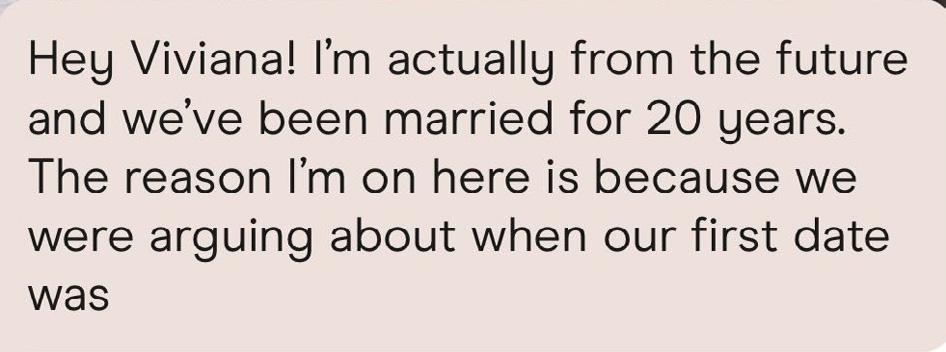

Viviana Arroyo receives a lot of forward messages from men on Hinge. Photos courtesy of Arroyo
Match Group, the company that owns Tinder, Hinge, and several other popular dating apps and websites, saw its stock plunge to an all time low last year with paying users falling by 6% from the year before. A Statista Survey from last year reported the apps are lost to Gen Z users, making up only 26% of users vs. millennials at 61%.
And for Chapman students, these numbers make sense.
Alessandra Robbins, a freshman animation major, believes dating apps have made dating “all the more casual.”
“I
don’t think many people value long-
Freshman animation major Alessandra Robbins believes relationships have become “all the more casual” thanks to dating apps. Photo courtesy of Robbins

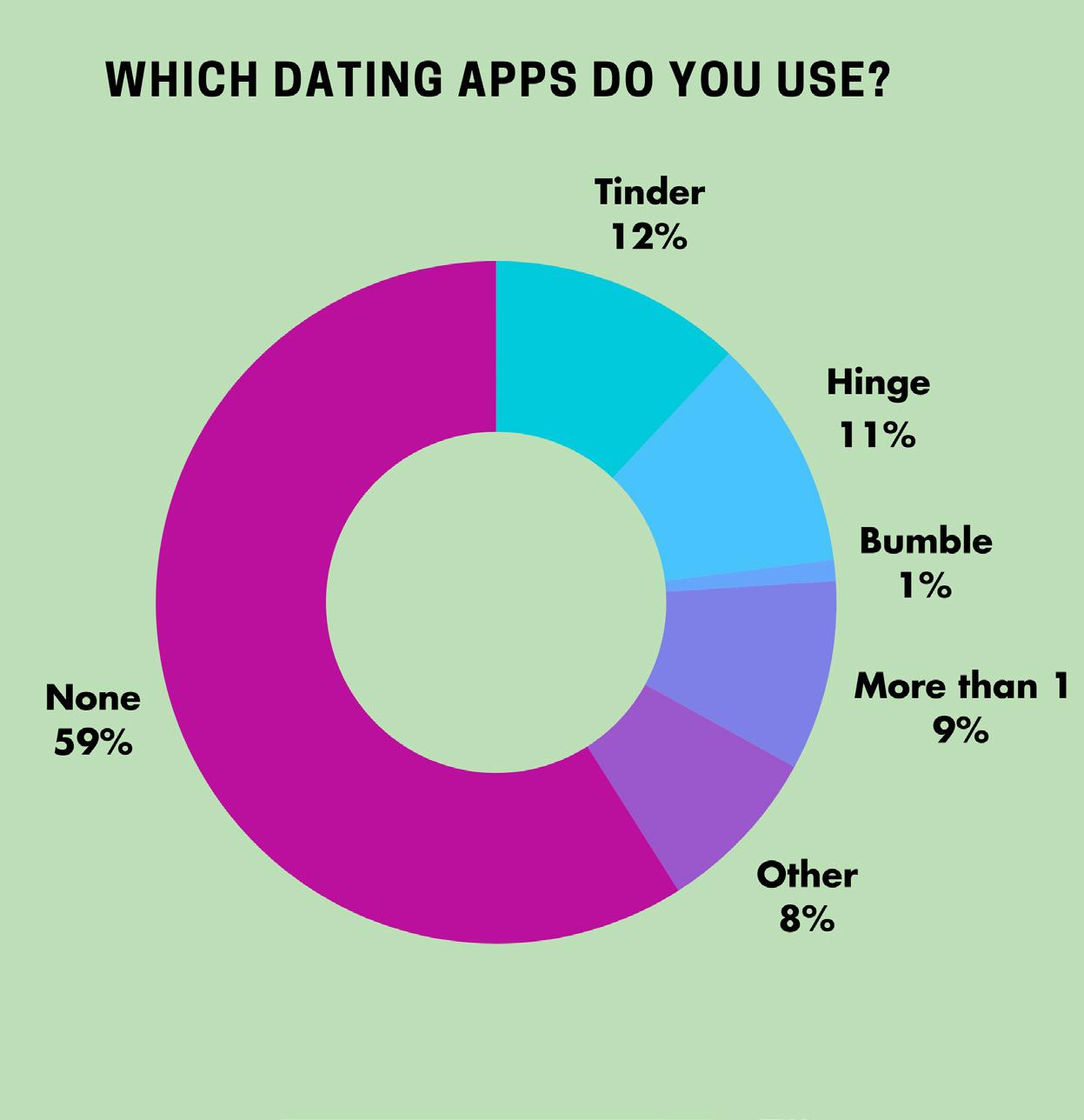
She added that a lot of people, including herself in the past, aren’t looking for a relationship at all on these apps, but free compliments: “It was definitely more of a validation thing.”
Sometimes that goal can get out of hand, though. Arroyo admits some of the messages she gets from men are a way too forward. “I’m actually from the future and we’ve been married for 20 years,” one reads. Another: “Babe just you’re smile alone makes me want to be a better man.”
Sophomore strategic communications major DJ Limp said that dating apps “don’t show others who you really are.”
courtesy of Limp
friend who used them and believed in people who said they wanted to be ‘exclusive.’ Turns out these people were cheating.”
But as dating apps continue to offer an infinite pool of partners and easyaccess to finding your “match.” It makes sense for some students to hit the download button.
“With dating apps, it’s so much easier to meet people, and then they don’t know who else you’re talking to,” said senior biology major Myriah Leah.

“I replied to people, but not when they were being weird,” she said.
But should the apps take the blame for users not using the app in the way they intended?
Photo Survey of 812 Chapman students via Fizz. Graphic by Lauren Cavalieri“Maybe it’s a change in the times. Maybe we as humans are getting more superficial,” said senior communications major Alden Ianelli.
Instead of blaming the users or the apps, some students think the problem lies with the lack of substance online interactions have. They believe there’s a big difference between flirting in person and over an app.
“I feel like you lose a lot, and it has a tendency to create a false sense of intimacy,” said freshman computer science major Jackson Feldman.
But for other students, the simple idea of not fully knowing someone online is enough to avoid the apps altogether.
“I think that when you are meeting with a complete stranger, not knowing what age they are and what they look like is scary

because they could be lying,” said freshman dance major Isabella Mendez.
However, there have been a few lucky couples to have come from dating apps. Riley Eaves, a sophomore English major, met her current boyfriend on Hinge. They talked online a for a month before actually going on their first date. Now, the couple has reached the past year’s marker.
“I don’t mind [dating apps],” she said.
She does acknowledge the fear of being ghosted online but states that users shouldn’t take it personally.
Her philosophy: “People just do what they want to do.”
Arroyo seems to make her verdict on dating apps.
“I can’t keep doing the same thing and expecting it to be different,” she said.

However, it won’t stop her from meeting someone one day. Maybe this time outside the walls of an algorithm.
“If I meet someone in person, at least it happened naturally,” Arroyo said.
Senior communications major Alden Ianelli thinks maybe the problem is us, not dating apps.
courtesy of Ianelli
PhotoFor my whole life my go-to tunes has always been pop music.
I’m not really into rap, country isn’t my vibe, and heavy metal gives me a headache.
Even though it seems basic, I’ve always liked the songs that were on the radio, the ones that everyone knew and could recognize.
When I was in middle school, I was a huge “directioner,” or fan of the group One Direction. I was truly obsessed, owning too many posters, CDs, and even bed sheets of them (I wish I was joking).
Until in 2016 when they broke up. I was shattered. Devastated. Empty inside.
“What group am I going to listen to? Everyone has a favorite group or artist, what will mine be?”
For almost three years I would listen to whatever was on the radio, never finding an artist that I connected to.
That was until the summer of 2019, while in a dance class with my friend Chiara, she showed me a group that will change my whole life for the better.

A seven member boy group from South Korea, my friend Chiara told me I had to give them a listen.
At first listen I was confused, I didn’t know what they were saying, and I couldn’t tell if I really liked the song. And then I listened to it again. And then I listened a third time.
I played their song, “Boy with Luv” all the way home that day. I was hooked.
First I learned their names. Then I started watching their music videos. Then I got into dance performances, which then turned into me learning the dances myself, which I would force my mom to watch.
The group was BTS.
One boy group turned into another, when I stumbled upon a video of the boy group “Seventeen” and started listening to their songs too. The cycle would start all over again. I was officially a K-pop fan.
I had a dozen of groups I was following, I bought their albums, merch, and started going to their concerts. I was deep into the fangirl life, and I loved it. I felt like I was finally filling the void the One Direction had left.
For a while it was all for fun. Then, it was January of 2021. COVID-19 had slowed down enough that I could move into my freshman dorm, and I moved in alone with no roommates. I was extremely homesick and had no friends going into Chapman.
Not even a week later, my boyfriend breaks up with me. School started the next week and I had to immediately drop a class because it was all remote and I wasn’t doing any of the homework in it.
I was extremely depressed, very lonely, and constantly on edge. I only had one thing that was keeping me from dropping out of school and moving back home. It was K-pop.
Whenever I was moping in my bed I’d watch a Youtube video of a boy group, or listen to some K-pop songs. If I ever needed to get out of my room I drove to the K-pop store and picked myself up something to feel better.
K-pop helped me in a situation where I felt miserable, and was one of the only glimmers of hope I had. Some people may think that sounds dumb, but it was true for me. I got out of that rut thanks to the music and videos these singing groups would make.
Sophomore year I was feeling better and was trying to get more involved on campus. I learned there was a K-pop dance team at
Chapman called Twilight. I auditioned and got in. I later went on to be a board member for two years. I’ve met lifelong friends from this club.
Fast Forward to today, I’m living with two people who I met in Twilight and have become two of my best friends. I’m still recovering from a K-pop concert I went to last week. And while I’m writing this I’m currently staring at my K-pop shelf filled with albums and memorabilia.
I was able to turn an absolute shitty situation into a great college career just because of a music genre.
Thank you, BTS.
 Marjorie with her friend Emma Walker at a K-pop concert.
Marjorie with her friend Emma Walker at a K-pop concert.
Some people are reminded of memories through photographs, songs, or items they’ve received from loved ones.
It could be something as simple as “Girlfriend” by Avril Lavingne that you heard in the second grade or something as strange as a large donkey figurine that your aunt gifted you for your birthday in high school.
But, the exciting thing about memories is that you can uncover them anywhere—in any shape or form.
As I finish off my fourth and final year here at Chapman, I have found myself reminiscing. Whether it’s regarding how awful I did in my finance class in junior year or how much love and dedication I put into reporting about the Maui wildfires for my internship at Hawaii News Now, it all still fills me with excitement as I delve into a new part of my life.
And, while some things haven’t remained constant in the four years, there is something very important to me that has.
My tattoos.
Why it may seem really weird to some, all 14 of my tattoos mean something to me. That’s because each of them comes with their own memory. Their own story. Their own accomplishment to celebrate or obstacle that I overcame in the past few years.
My first tattoo—a lady with flowers—came at a very low point in my life. At the beginning of my sophomore year of college, my grandmother was diagnosed with breast cancer. Her fight was long and brutal and in the end, she didn’t make it.
She passed away in December of that same year.
I got my first tattoo to keep her close to me—and with it, I’ve never felt closer. I remember how she would always smell like plumeria—a flower native to Hawaii—and it’s the reason my tattoo is embellished with flowers.
For my second tattoo, I got it just two


months later with my best friend. A strawberry plant on the right side of my back. My friend got a koi pond on his left thigh. The two of us have been inseparable since the 7th grade and even though he lives in Hawaii while I’m up in California, it has kept us connected over the last three years.
My third tattoo was a spur-of-the-moment decision at a swap meet in Anaheim during March 2022. The tattoo cost a mere $20 and was done in a small room at the back of the building. Both my close friend Nicole and I got cheap tattoos—mine, a small heart with flames on my collarbone.
If you ask to look at it, I will hesitate. It’s just really ugly.
But, it symbolizes a growing friendship and bond between the two of us. Fast forward two years later and our friendship is stronger than ever. We’ll be moving into a house together in Los Angeles, beginning August of this year.

For my fourth, I got it in Hawaii in the summer of 2022. An angel and devil holding a heart located on my right thigh. The reason: I had just quit a really shitty summer internship in Santa Ana and moved back down to the island for the summer. It was a hard choice, but the right choice. This tat
too represents that.
My fifth tattoo was just two weeks later with the same artist. This one is still one of my favorites—a doodle of a sheep that I named Shaun—who lives on my right elbow. I won’t lie, there’s no real memory behind this one. I just thought he was really cute.
won’t lie, there’s no real memory behind this one. I just thought he was really cute.
And yes, I was a huge fan of the cartoon show, Shaun the Sheep, growing up.
An abstract-looking angel on my left forearm was my sixth. This tattoo to me symbolized the universal idea that everything happens for a reason. I remember getting it two days after my partner and I broke up in the fall of 2022.
While devastated in the moment, I look at it now with hope and excitement for the future.
My seventh tattoo was a strawberry cake on my left thigh that I got in west Los Angeles in December 2022. It came at a very celebratory moment in my life: I had just declared my second major at Chapman— English journalism. I remember being so excited to have finally found a major that I was extremely passionate about.
To be honest, my business major just wasn’t doing it for me.
The eighth tattoo—a fairy perched on a bellflower—has been sitting on my right shoulder since January 2023. It reminds me of the close-knit connection my sister and I share.
“The fairy kind of looks like you. You both have curly hair,” she said as the artist
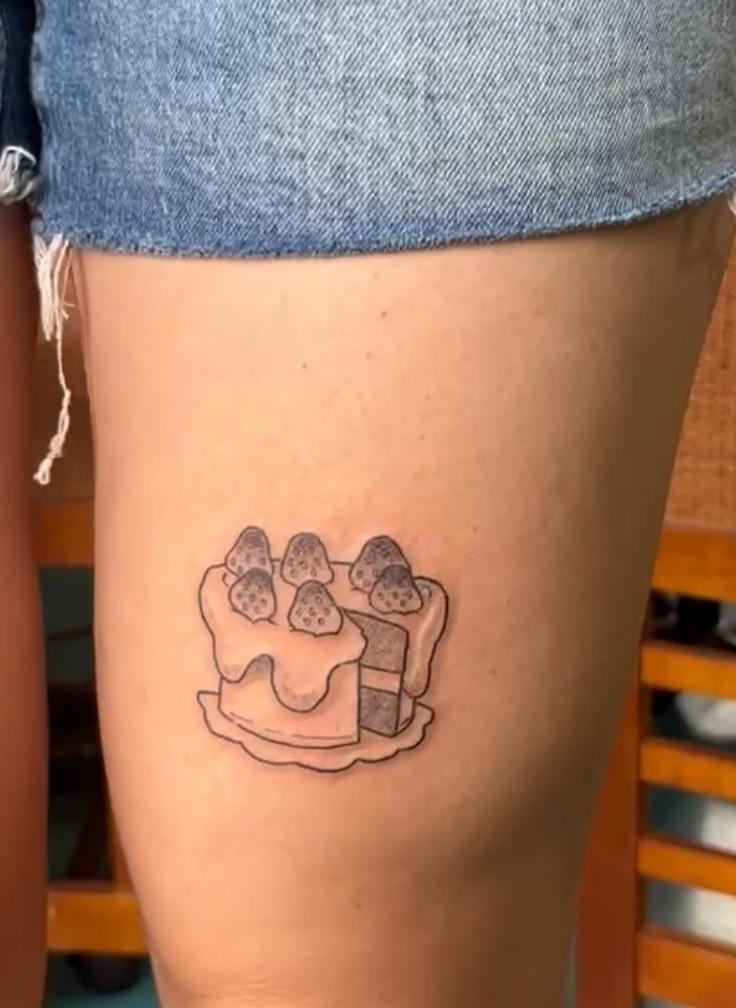
draped the tattoo stencil over me.
That quote has been stuck in my head ever since.
It was also during this time that my sister was beginning to apply to colleges and my parents asked me to help her out with the whole process. Shout out to my fellow firstgen students.
Number nine is where things get a bit blurry.
But, my Miffy tattoo on my right arm should be the next one if I’m counting correctly. This one was done with the same artist who did my strawberry cake tattoo. It signified a huge milestone in my professional life for journalism.
But, my Miffy tattoo on my right arm should be the next one if I’m counting correctly. This one was done with the same artist who did my strawberry cake tattoo. It signified a huge milestone in my professional life for journalism.
I remember receiving the call from the national Dow Jones News Fund journalism program that I had been accepted as one of its students for its annual summer internship. I was going to be a digital media intern at Hawaii News Now—one of the most well-known news stations in Hawaii.
I remember almost falling down, calling up my parents, and booking my Miffy tattoo appointment all in the span of one hour.
My tenth tattoo comes from Studio Ghibli’s Ponyo.
I remember getting this tattoo in Los Angeles in April 2023 alongside Angelique, my big in my sorority. Ponyo is my third favorite movie of all time—behind Big Hero 6 and Little Women—so after seeing this flash design on Instagram, I knew I had to have it.
The tattoo rests on the inside of my left arm near my first tattoo—the one I got for my grandmother. Now over halfway through my junior year, memories of her circled within my brain. She loved Ponyo.
My family and I would watch it together every year during Thanksgiving break. It only felt fitting to put the lovable character permanently on my skin.
The 11th tattoo is an homage to my love for Sanrio. Hello Kitty. Kuromi. My Melody. Pompompurin. All of them. I became obsessed with Sanrio during 2020, and it only felt right to finally get my obsession tattooed. Now, the flan-inspired character Pompompurin sits atop my left shoulder for the world to see.
A mirage of tattoos wouldn’t be complete without a family one. Coming back home to Hawaii for the summer of 2023 was a big one, especially for my mother. My sister was leaving for college soon in Las Vegas and it would be the last summer we were together.

My mother surprised the two of us on our final day in Hawaii by taking us to a small tattoo parlor in Kapolei—just a 15-minute drive from our house. There, the three of us got matching tattoos on our right ankles. A treble clef surrounded by tiny stars.
Was it a bit cliche? Yes.
But, do I still look down at it and smile? Absolutely.
My 13th tattoo is another homage to my love for Sanrio. A double feature, I know. Kuromi—colored in pink and black—sits on the back of my right calf and while super cute, serves as a testimony to my healing journey.
While my partner and I broke up back in fall

2022, we kept in close contact for a year af ter. We were in the same friend group, which made things increasingly dif ficult. It wasn’t until September 2023 that I knew it was time to fully cut contact. The con stant breakdowns I had. The feelings of not being good enough. It was dreadful.
Through all that pain though, he seemed to be moving on with ease.
Finally, after months of going back and forth, I did it. My Kuromi tattoo followed just a week after.

While it hasn’t been an easy journey since then, cutting contact was necessary for me to be able to find myself again.
And in the present day, I can now say with ease, that I’m doing much better.
To wrap up, my 14th tattoo—a girl wearing a bellflower hat holding her pet ladybug—is permanently etched onto my right forearm. I got it in January 2024 in Hawaii when I visited family and friends for winter break.

To me, it symbolizes new beginnings.
2024 was and so far has been a crazy year filled with making new friends, starting up therapy, preparing for graduation, and planning what my future will look like post-grad.
It’s been scary, but that’s the thing with new beginnings. They always are.
As I continue on my professional, personal, and heaing journey, glancing at this tattoo helps to remind me that change isn’t a bad thing. It allows me to question myself, stay open to potential opportunities, and make new memories.
Currently, my goal by the end of 2024 is to hit 18 tattoos.


Sometimes it only takes the sound of bullets flying over your head to know that you can handle dangerous situations better than you thought.
It was Thanksgiving 2021, and I was in the Bay area visiting my family. My high school had a championship game while I was there, so I decided to go with some of my old buddies. The first half was fine, “we” were winning and the vibes were high. Then, I heard something scary.
Pop pop pop pop pop!
Gunshots don’t sound like what you’d think. They don’t have the boom of fireworks. They’re not even loud. In fact. Most people didn’t hear it.
But I did.
The thing is, my ADHD, which is technically a disorder, allowed me to put all my attention on my surroundings at all times. Not the football game, but everything else. So while nobody heard the first shots, I did.
I took my friends and we started running. Down the bleachers, to the far gate where I felt we wouldn’t be in danger. My friends stopped, confused because they didn’t hear anything. Right as I started second guessing myself, it happened again. Louder this time.
Everyone started running.

Thanks to my ADHD, by the time it got really bad, I had jumped the far fence and helped my friends over as well. We ran across the campus and got to safety.
ADHD is a pain in the ass. But it just might have saved my life.
To put it simply, what it feels like for me is that there’s one thing I should be focusing on, but instead I’m focusing on everything else. That means I’m typing this sentence while I’m looking at every little item on my desk, or noticing that my smart lamp is slowly dimming to show the end of the night. It sucks to have ADHD in a society that rewards the repetitive nature of work.
But it wasn’t always like this.
Numerous studies have shown that older civilizations, like hunter-gatherers, were led by those with ADHD traits. This is because it naturally causes the person to gravitate towards the most interesting thing, the thing that your body and instincts believe is something you need to pay attention to. So, they would notice small yet important details like an animal’s movement pattern, or a sound in the distance signaling an attack.

That part of my ADHD doesn’t show up often, but it’s happened enough to the point where I can be just as grateful for my “superpower” as I am discouraged by my daily struggles to keep on a task.
It’s been something that I’ve believed was a burden since I was 13. I failed classes, lost friends, and struggled in just about every part of my life due to it. It’s caused high highs, and even lower lows. It gave me depression so deep that I genuinely considered dropping out of school and giving up on everything.
My work to overcome it is one thing. I’ve worked hard to deal with symptoms, learn about what works for me, and put myself in a position where I feel confident I can handle a lot of what life might throw at me. But I never felt grateful for my ADHD until that Thanksgiving night.
There have been more times since then that the “superpower” has been activated. Tense moments in bars, near-accidents on the highway, etc. They all could’ve ended much, much worse if I didn’t have that little war-captain in my head telling me subconsciously what the right thing to pay attention to is.
One of my friends had a bullet hole in their truck that Thanksgiving night in 2021. It ended in two people going to the hospital and the police holding everyone in the crowd laying low while
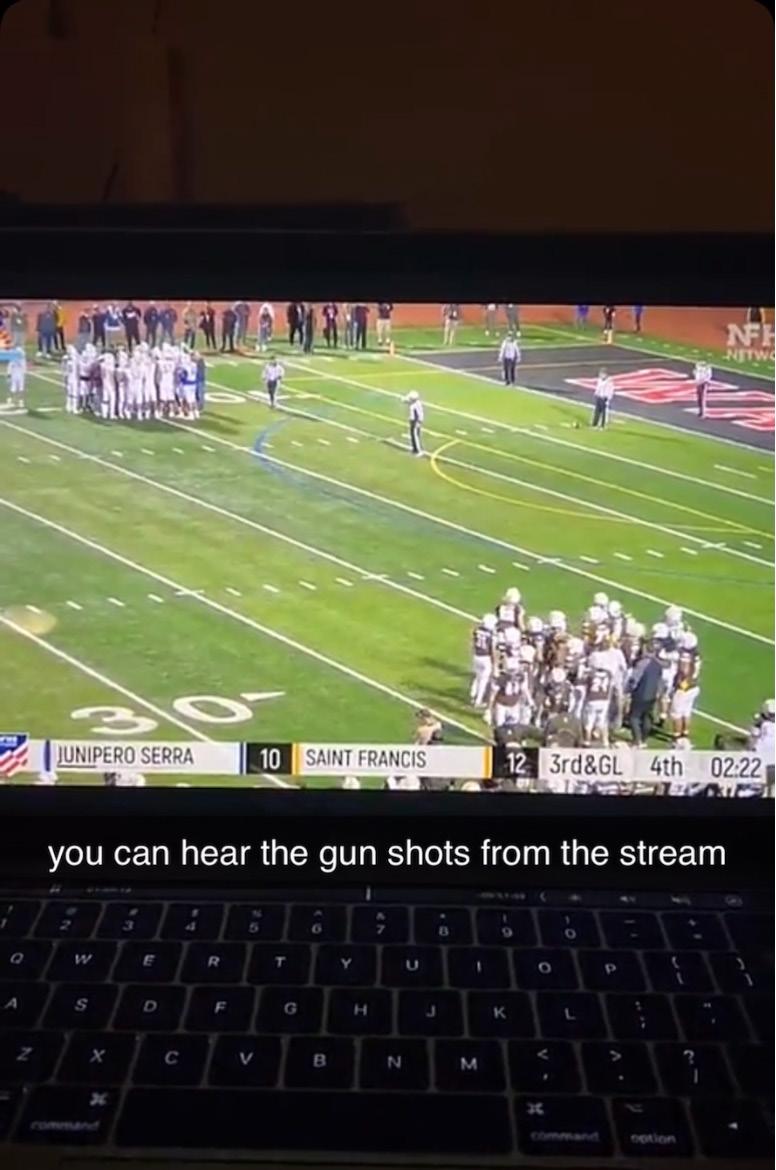
A screenshot of the broadcast from the game that night.
they searched the perimeter. By the time that happened, I was at my house safe and sound, thank God.
My point in all this is to remind you that, no matter what you have to deal with physically or mentally, it’s more than just a burden. Something you thought might be holding you back might be valuable in another facet of life. Enjoy everything about yourself, every perceived flaw or quirk, because there’s a place for it in this world.
 By Sarah Hart
By Sarah Hart
“You should go blonde,” my boyfriend had told me.
I remember staring at him. We’d only been dating for a month or so, so he didn’t know at the time that I’m a natural blonde. How would he? When we first met I had medium-length dark brown hair and bangs.
My hair had been brown for nearly three years by the time my boyfriend had told


sophomore year of college.
me I should go blonde. But I had been dying it for much longer.
My freshman year of high school I wanted to make a change. My hair had been dirty blonde and long for my entire life. I remember one time in middle school my mom had let me get highlights that turned out looking highlighter yellow, which in 7th grade I had loved, but by 9th grade made me cringe.
I was starting high school. I wanted to look old, like a teenager. The next time my mom took me to my annual pre-school-year haircut, I told her that I wanted something different. My mom wouldn’t let me dye my hair any crazy colors, but she did let me make my hair lighter. So freshman year of high school, my hair was icy blonde.
At the end of my freshman year, my grandma wanted to take me to get my hair done to celebrate the end of my first year of high school. I still wanted to look older. We went
Me, Photo courtesy of Lisa Wong Me, freshman year of high school, at the roller rink. Photo courtesy of Ella Acciaccato Goldenwest College, where at the time you could get your hair cut by cosmetology students for cheap. I opted to get bangs.
Everyone’s reaction fulfilled my need to receive attention. I became the girl with bangs. Whenever someone described me, they would bring up the fact that I had bangs first.
“You know Sarah? Bangs, blonde, white girl? Sophomore?”
And this was fine with me, for a while. Then during my sophomore year, we had to transition to online school. At first I was fine with my hair growing shaggy. With my roots growing in. Then I got bored.
My transformation started with online shopping. I ordered things like bright clothes and colorful eyeliner that would make me look like I was interesting and fashionable. The justification was that I would wear all of the cool clothes and do my makeup in interesting ways every day once I got to go back to school. That’s what I told myself, anyway.
It was only a matter of time before I changed my hair too.
It started with pink streaks. It made me feel confident and adult. I felt really cool, like the kind of girl who had over 1,000 followers on instagram, that did activism, that was effortlessly able to look like she doesn’t care about how others perceived her.

So I kept going. My head was pink, purple, red, and blue, on and off again in no particular order. I cut microbangs and drew my eyeliner on so thick and long that my liner wing was longer than my eyebrows.
The summer before my senior year, I finally got to go back to school shopping in a real mall again. After a year and a half online, I was ready to make my debut as a fully in-person senior at Huntington Beach High School.
On a whim, I dyed my hair brown. It was the biggest change so far. The other colors
I’d done had been extreme, but I had never fully covered my blonde roots before, and I’d never had a color so dark on my head.
And so I started senior year.
The brown hair was good. I think because it had been so long since my classmates had seen me in person that most of them had forgotten I had been blonde, which was exactly what I wanted. They saw me as someone who was grown up.
The Friday before Thanksgiving break was the worst day of my life. I came home late after eating out with my friends. My dad stood in our kitchen. I remember it was dark, with only one lamp on. I remember thinking it was weird that the TV was off during the Lakers game.
My sibling was in the hospital. They had tried to take their own life. He had to go back to the hospital now because my sibling was still being processed, but he wanted to tell me what had happened in person.
Nearly 50 percent of non-binary kids aged 11 to 17 attempt suicide. My English teacher had told us that statistic near the beginning of the year. I mused this statistic over as I sat in the salon chair at a hair appointment during Thanksgiving break that I had planned a month in advance.
I ended up making my hair even darker at that appointment. I liked how it made my blue eyes, intended to be paired with blonde hair, look.
That same year, I got accepted to Berkeley, which was somewhere I had really wanted to go for school. I lied and told my parents I was rejected, and opted to go to accept a scholarship at Chapman instead so I could stay close to home, in case anything happened.
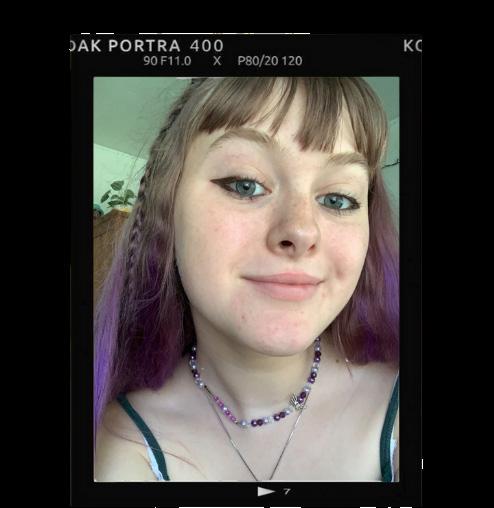
I dyed my hair dark red the last week of UC admission decisions.
The week before I moved into college, my hair had faded to a light scarlet color. In a panic, the night before move-in I wasted two boxes of dark brown dye to make my hair look better, but it didn’t work. I started college with red hair.

Me , at my high school graduation. Photo courtesy of Isabelle Scarpino
Since the red faded, I’ve been dying my hair dark brown over and over. It’s stable. Most people I’ve met since starting college, like my boyfriend, haven’t seen my real hair.
Why don’t I stop dying my hair?
I don’t know. I guess in some way, it’s hard to see myself as blonde again because it feels like the blonde version of myself is lost. I can’t go back to being 14 years old, having never dyed my hair before. Hav-
ing never heard of Zoom, worn makeup to school before, drove a car, gone to therapy, smoked weed, kissed someone.
I don’t know if I could look at a reflection of myself in the mirror if I had blonde hair. It would remind me too much of everything I’ve experienced since I was blonde. I don’t know if my body could take it.
But who knows. It’s just hair.
Ithink everyone has dreamed about dating a musician, at least once in their life. That dream, I also once had after seeing Charlie Puth in concert when I was 12, is now my reality.
I met my now boyfriend, when I was 17. He was playing a small concert in my hometown and I went up to him and asked if I could play with his drums. I twiddled the drumsticks around and flirted with him just enough to get his number.

Us at the WhiskeyA-Go-Go
My mother often recalls the first time I told her about him.
Blushing and giggling, “Mom, he’s a drummer.”
Her excited smile faded just a tad. Drummers have a shitty reputation, you know?
From Tommy Lee to Peter Criss, my mom’s mind imagined what this kid could be like.
Well, that was three years ago and I’m still dating said drummer. Surprise! The lore of dating a musician is crazy, but most of it’s true. Going backstage of concerts, being the “rockstar’s girlfriend”, meeting ing famous people like Rob Trujilo (bassist of Metallica).
So have I convinced you to date a musician yet? Yes?
Hang on. Dating a musician is not for the weak or faint of heart. Let me explain why.
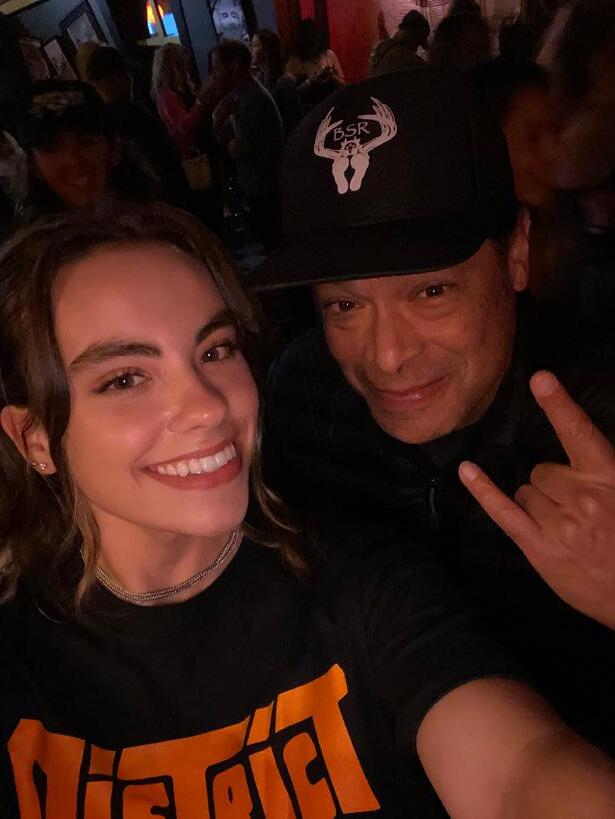
Within the past year, my boyfriend has started to tour. Yippee! He is gone for weeks at a time, traveling out of the country or to a different state each day, playing shows, meeting new people, and being a rockstar 24/7.
Rob Trujilo and IThe down-side of that, he also misses important things, like anniversaries, parties, dinners, and family events, because he is at whim to his schedule. If a show comes up, he has to play. It’s his job. So basically, we’re in a part-time, long distance relationship.

The transition for us, specifically me, was and still is hard, because I had to accept that I did not come first anymore. Some of you might not be okay with that, and at first I wasn’t either. I struggled to accept my position as runner-up to a drum kit. It’s rather humbling when I phrase it like that.
Sometimes, I crave little things that I don’t often get to have in my relationship. I don’t get to walk around campus with my lover, hand-in-hand as the beautiful socal sunsets. We don’t go grocery shopping together to prepare for another long week of classes. I also can’t call him and casually ask him to come over. In order to see him, we usually have to plan at least a week in advance.
However, I’m learning that comparing my normal to someone else’s normal is not only unfair, but can make the transition harder.
I’ll be the first to admit that my boyfriend is the most tenacious, hard-working person I have ever met in my entire life. He has overcome adversities, pushed himself beyond his limits, and surpassed everyone’s expectations of him.
He made me realize how hard one needs to work to be that good. As someone who is also going into the entertainment industry, I know that success is never guaranteed. It’s rather daunting, but he makes it look easy.
Before he started going on tour, we were together almost every weekend. I was very dependent. But since we’ve stopped seeing each other as much, I have grown so much. The physical distance between my boyfriend and I caused us to grow closer emotionally and mentally. We support each other constantly, whether we’re in-person or not. I have learned to communicate my needs with my boyfriend while he’s on the road, I have learned to not be apologetic about how I feel, and when I need to stand up for myself.
But this is what love is about. When you find that person, making it work is so worth it. Because at the end of the day, he’s my person and I’d rather work through the hard parts than not be with him.
I give him a lot of credit for inspiring me to be so hard-working. He doesn’t know it, but he pushes me everyday to work harder. He makes me want to be a better person.
